#edited to include zon's name
Text
i still hate how the onus was on zon and his people to "prove" that orcs were capable of more than violence meanwhile marcille didn't do a goddamn thing to change their minds about elves being raging bigots. funny how she thinks elves (a long-lived race with powerful magic) and orcs (a short-lived race with no magic as far as we can see) are on a level playing field when it comes to securing land and resources!
and having bahai, zon's child, be the one to go "why can't we all just get along" like ooh ryoko kui some crimes cannot be forgiven
#dungeon meshi#fantasy racism#she captured white ppl microaggressions against poc perfectly but cannot commit to portraying actual oppression#and with current events marcille's demonization of the orcs who are obviously fighting to keep their autonomy reads so so awfully#tfw you struggle w depicting oppression bc then you'd have to come to terms w the horrors your country wrought in east & southeast asia#ryoko kui 🤝 hiromu arakawa#interesting how the 'how laios & shuro met' comic generated more racism discourse than ep 4 of the anime#calemonsito notes#edited to include zon's name#i thought his son had an official name too but i can't confirm it in the world guide#edit 2: found his name!#just a lil tidbit: bahay means house in tagalog
76 notes
·
View notes
Text
mystik spiral rate youre music page
Icebox Woman
by Mystik Spiral
released 1998
recorded 1992 - 1997
2.33 / 5.0 from 70 ratings
Alternative Rock, Garage Rock, Post-Grunge
Grunge, Noise Rock, Power Pop, Indie Rock, Neo-Psychedelia
lo-fi, raw, angry, noisy, lethargic, introspective, dissonant, psychedelic, melancholic, energetic, depressive, self-hatred, nihilistic, existential, occult, rebellious, spiritual, pessimistic, male vocalist, LGBT, atonal
4 Reviews
cumguzzlinggutterslut
★★★✩✩
i liked the part where those 2 guys howled like wolves that part was funny
30000monkies
★★★★✩
takes me back…i used to play at the zon in the 90s & actually met the guitarist after a gig when i went to use the bathroom. nice guy. i think his name was jerry? he gave me a blowie in one of the stalls & sold me the CD for $20. great stuff! would recommend!
dreamtheaterfan8000
★✩✩✩✩
Pure drivel. I cannot recall a single moment during my first (and only) listen of this garbage where I wasn't appalled. HOW DID THIS TAKE 5 YEARS TO RECORD????? Let us delve into the musical septic tank...
Mystik Spiral is yet another perfectly mediocre post-grunge band that has decided to unleash onto the unwitting public the suburban angst they've carried with them and kept latent since middle school. My first question: What the fuck is a Mystic Spiral? Is it supposed to be a metaphor for their career? It sounds like the name of a Doors cover band. Initially I assumed the misspelling of the word "mystic" to be intentional, but after finishing the album I am fully convinced the members are all semi-literate. Take these lyrics:
"The universe is a cold, cold place, black and Bleak like outer space, the wind chill drops below sub-zero, it's not no time to be a hero."
Woooooow. Didn't know the temperature could drop "below sub-zero," or that poetry you wrote for your Language Arts class when you were twelve constitutes as genuine lyricism. And who still rhymes "zero" with "hero?"
Fortunately, Mystik Spiral is allergic to songs over two minutes in length, making this a much less tedious listen than expected. This compliment is backhanded, as the "songs" are excretions of verse-chorus crap that barely hit the one minute mark.*Yawn.* There is nothing in this album that resembles originality. Why bother writing memorable riffs when you don't even know how to fix that buzz in your amp? Wait, I'm getting ahead of myself.
The playing, if you can call it that, sucks. In spite of their apparent obliviousness to the concept of tuning, or practicing, so-called "guitarists" Trent Lane and Jesse Moreno have discovered an ingenious way to hide their sloppy guitar work: drown everything in as much feedback as possible. I cannot stress enough the fact that Mystik Spiral's sound is that of two college students arguing on top of TV static while someone living in their basement plays the drums. Props to the drummer, by the way, for managing to keep a simple 4/4 beat to this tuneless nonsense. I don't know why Mystik Spiral has a bassist, though. I could not hear him, except some songs where he starts playing too early & they decided not to do another take. It's like they're so ashamed to have him in the band they buried him in the mix until he was completely inaudible. Then I read that Mystik Spiral didn't even have a bassist until 1996, four years into the recording sessions...Who cares, man? It's called artistic liberty. Such is fate for so-called "alternative rock...." It should be illegal for bands to keep trying to emulate Nirvana and the Screaming Trees. Also, was it really necessary to include a 30-minute audio recording of a woman giving birth as a hidden track?
EDIT: After posting this review that took me a week to write I got a lot of messages insisting there was no childbirth recording & that I'm crazy. I swear to God it was there. It took up over half the album's runtime. How on earth is no one else hearing it?????
JesusSaves1968
★★★★★
This album gave me the first erection I've had in 30 years
4 notes
·
View notes
Text
as someone who has been a die-hard, non stop fan of the grishaverse for eight years (eight!!), who has every book released including collector’s editions about this series (lives of saints, demon in the wood, language of thorns,) you name it, i am begging you all to sign the petition -
link
- to express interest in a continuation of the series, and share it with EVERYONE you know. with enough signatures, another platform might pick up the show, (tweet or dm am*zon prime video about this if you can,) or netflix might change their mind.
please remember to stop spreading criticism about the show’s writing in this rocky time, streaming platforms everywhere are scanning the internet to see if shadow and bone might still be profitable and we need to FIRMLY state that we LOVED it, and we WILL watch more seasons NO MATTER WHAT!!
the fandom continually criticizing the plotline of the show is definitely one of the reasons the show was cancelled. the other is probably that eric heisserer was involved in negotiations for sag-aftra and netflix wanted to hit him where it hurts. so spread the petition, blow up social media, don’t shut up about it!
#shadow and bone#six of crows#netflix#grishaverse#kanej#crooked kingdom#leigh bardugo#boost#boost!!!#signal boost#buy the books too if you can / borrow on libby
8 notes
·
View notes
Text
Fake ebooks on Amazon.
So the scammer makes a free 4 page "book," slapping together a vaguely plausible cover, with a link inside leading to their pirate website – where they sell (maybe complete but who knows; they're scammers) pirated ebooks for like $4. (This free book is also on KU, and I don't know how that works 'cause Amazon doesn't like permafree. They're likely getting a few pennies out of KU for this and I'm sad I'm not a scammer.)
The scam ebooks have only 4 pages, and get attached to the actual book, supplanting the legit ebook because Amazon shows the cheapest one & they're ~free~; the legit ebook can be found under an unobtrusive link for "other editions."
The scam books are all by "BY [author name] (AUTHOR), and they seem to all have the title including "(a fascinating story): Illustrated".
If you're a published author, check your pages and work on a DMCA takedown if they've hit you. Or get your agent or publisher to do it; you'd think the Zon Empire would notice these books are linking to outside sites, but noooooo...
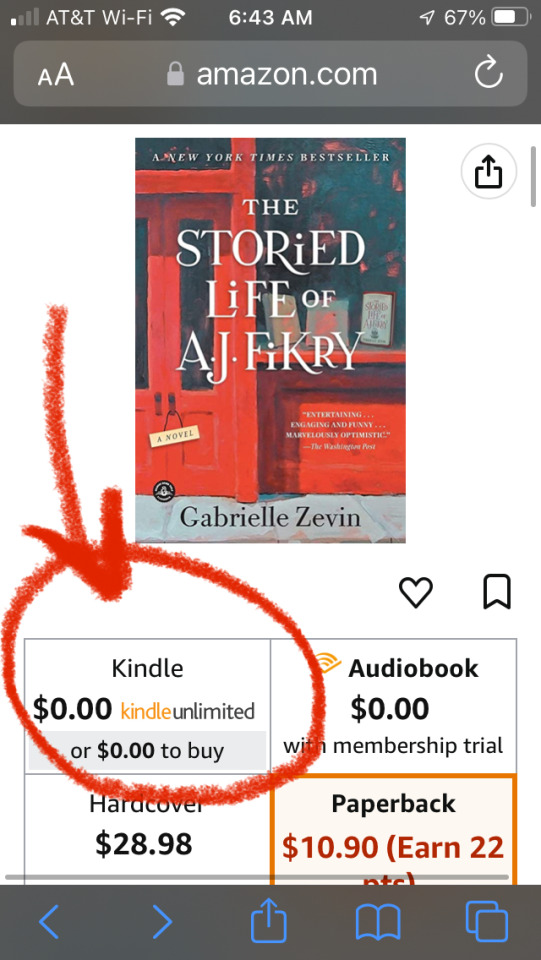



2 notes
·
View notes
Note
13 and 15!
13. do you have a goodreads?
Yes. I am aware it is not a good thing and I tried Am*zon-free alternatives (a couple of them were actually very good and I will link them as soon as I remember their names), but few of them included English editions only and I try to read in my mother tongue as much as possible. So, yes I do, ugh. Please.
15. recommend and review a book.
I haven't reviewed a thing since high school, I have no idea how to do it. Read A. Achmnatova's Requiem, dear people, it is genuinely swell.
#the reviewer nobody need and many deserve#my goodread is 'ginkovskij' btw you can follow me and see how the reading list grows and not a signle title in there is ever finished#thanks for aswing!#ask meme
1 note
·
View note
Text
I haven’t posted much about my Pathfinder video game characters yet, but I figured I should make some sort of compilation post, because there are quite a few now.
The artwork is the portraits I used for them in-game, some from custom portrait packs, and most of them are only an approximation of how they look. But I’m no artist, so, ya know. I also included the mythic path edits I did for my WOTR characters because they didn’t turn out too bad.
Wrath of the Righteous

(official artwork)

(Angel edit using artwork from Magic the Gathering)
Name: Tuyen
Race: Angelkin aasimar
Class: Shaman (Possessed) / Bloodrager (Spelleater, Celestial)
Mythic Path: Angel
Romance: Arueshalae
Other character details: A healer from the city-state of Goka. Maternally descended from aasimars from Tianjing, and from the empyreal lord Ragathiel. Hosts a zuishin kami spirit named Teki. Turns down Iomedae’s offer to join her angels and leaves Drezen after the war.
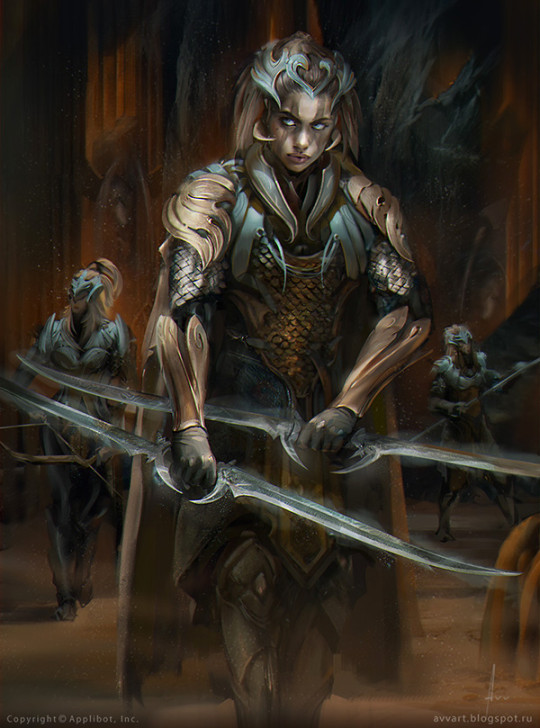
(source - this is obviously not a tiefling, but listen, the situation for tiefling portraits out there is dire)
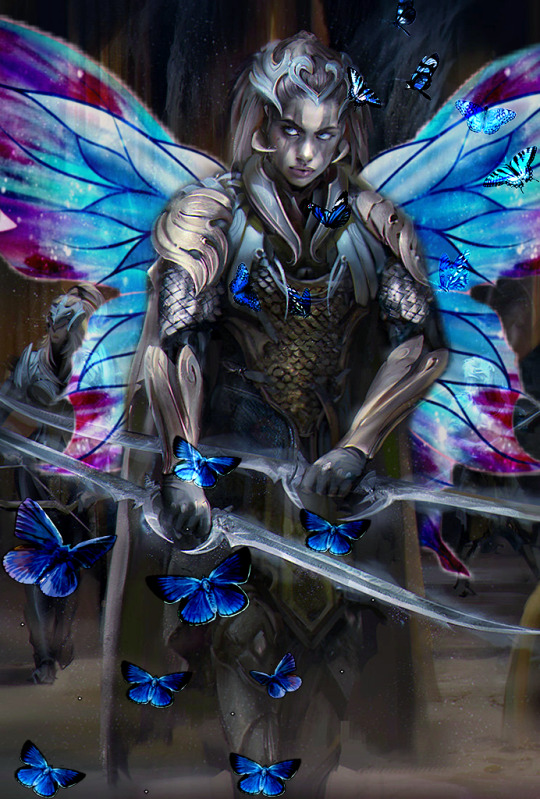
(Azata edit)
Name: Auri (or Aurika)
Race: Daemon-spawn tiefling
Class: Oracle (Plagued)
Mythic Path: Azata
Romance: Daeran
Other character details: A librarian and book dealer from Absalom, formerly from Orlendas in Iobaria. Descended from the possibly dead and former Horseman of Pestilence, Yrsinius. Begins the game as a Lawful Neutral worshiper of Zon-Kuthon and eventually becomes a Chaotic Good follower of Shelyn. Has a death-touched horse companion named Onyx. Stays to rule Drezen after the war.
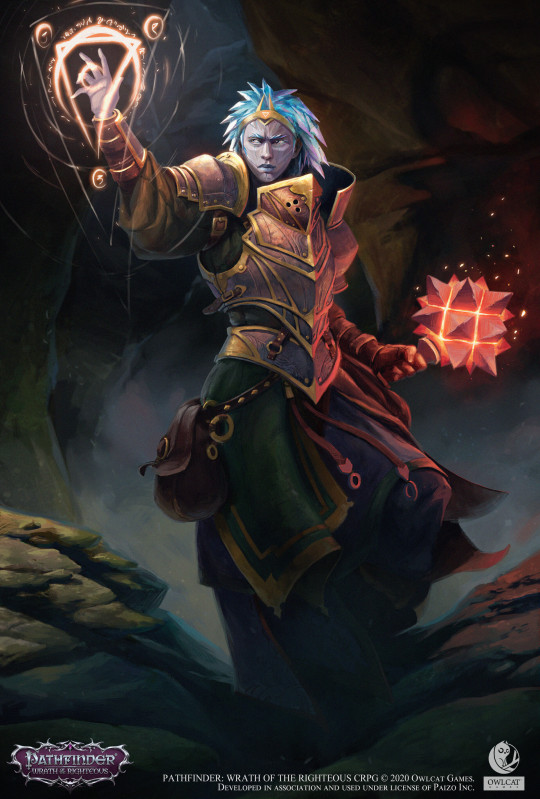
(
source
- also an official portrait)

(Gold Dragon edit)
Name: Kohar
Race: Gemsoul oread
Class: Kineticist (Elemental Engine - Earth)
Mythic Path: Trickster to Gold Dragon
Romance: Lann
Other character details: A performance martial artist and sometimes-grifter from Varisia, formerly from the city of Janderhoff. Descended from crystal dragons. Leaves Drezen after the war but stays to guard what remains of the Worldwound.
Kingmaker
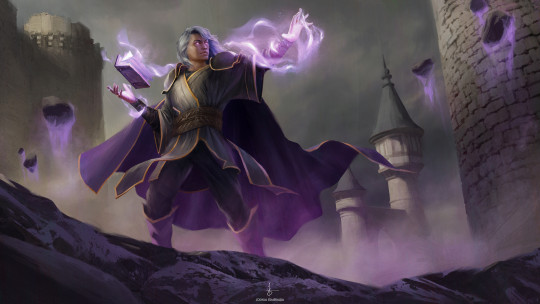
(source)
Note - Pathfinder drow lore sucks, and I’ve rewritten a lot of it in my head for Hadrian. They’re cool now.
Name: Hadrian
Race: Half-drow (half-elf in-game)
Class: Magus
Romance: Regongar and Octavia
Other character details: A drifter from the Darklands, who came to the surface after being exiled from his home colony for consorting with Zon-Kuthon worshipers and intellect devourers. Hosts a rogue intellect devourer named Marrow in his brain and worships Zon-Kuthon. Shifts from Chaotic Neutral to Neutral Good over the course of ruling the barony, and becomes the Lantern King’s herald.
Kingmaker - Varnhold’s Lot DLC

(source)
Name: Danae
Race: Gnome
Class: Wizard (Thassilonian Specialist - Wrath/Evocation)
Romance: Maegar
Other character details: A former Cyphermage from Riddleport in Varisia. Joined up with the Varnling Host after hiring them for a job for the Order and realizing how bored she was with staying in Varisia.
14 notes
·
View notes
Photo
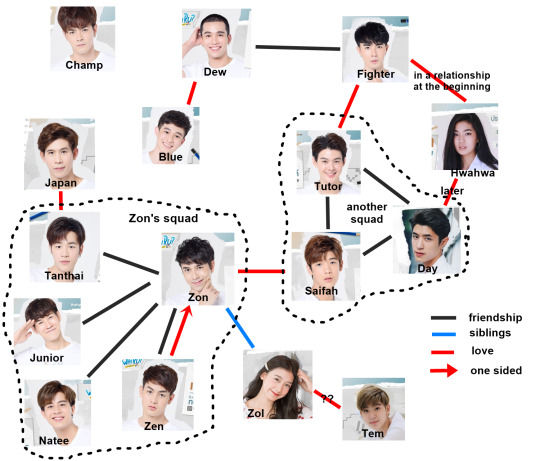
very rushed why r u character chart. all the names are from mydramalist and relationships are based on the teasers. there might be mistakes, but i’m pretty sure that’s it. i didn’t include minor characters (as the parents or the cafe owner).
zon/saifah and tutor/fighter are BOTH the main couples.
also there might be other couples?? i’m not sure at all about zol and tem. and if i were to guess, maybe they would pair champ up with one of the boys in zon’s squad. also most of the boys on the upper right are on the football team. so this is how everyone kinda knows each other.
edit: just realized, i don’t think zen liking zon is confirmed but i just assumed it from zen’s behavior.
edit 2: it’s me, back again! zol apparently will be paired with natee, not tem.
hope this brings some light.
95 notes
·
View notes
Text
why r u ep 2 thoughts
small gripes to get out first!
the massive amounts of side characters that i have no idea about increases. i wish zon’s little squad was maybe two people.
also the editing. there were scenes that needed to be chopped much smaller to flow better. if the first ep was a bit fast, this ep dragged its feet
now...content
wonderful to see tharn and type. type being unpleasant and combative from the beginning? perfect. i love one bastard man.
type and tharn ending up as some sort of relationship advice source in their own series is still so funny to me, and it continued here. zon’s reaction to them, is how i often feel when confronted with type, a sort of awe and horror. (fyi, im big type fan, but i also want to fight him 24/7. i hold multiple and equal opinions)
don’t like the rp shipping plotline, but to get to the reward of saifah and zon, we must experience the mortifying ordeal of Extreme Trope plotline and apparently that includes people shipping others openly.
mentioning saifah and zon, their interactions make this show for me. zon’s absolute determination to bodily intimidate saifah? amazing. wonderful. perfect. their height difference caters to me, lmao.
and i like that what we see now of saifah is that he’s kind of a goofball. it makes the oncoming romance much more enjoyable an idea for me.
fighter and tutor? hmm. the show isn’t selling me on it as a whole, but they had their moment in the bar which i liked. again, fighter was goofy. i love it, that’s neat. give me goofball over aloof jerk anyday.
i get that fighter is pining, and in denial, and doubling down on his mistakes because he fucked up once and doesn’t know how to change that. i just...i don’t feel the same thing from tutor. i haven’t felt that he has the same level of fascination. he just seems kinda annoyed. and that can’t sell me on a relationship.
but they do have chemistry, and as the story progresses, i’m hoping to change my mind
so in summary
+ zon tried to bodycheck saifah. phenomenal work, my son
- zon and zol’s super hot mum was not present in this ep
+ i like the cast, i like their overall vibe with one another
- so many boys. lets get rid of some of these extraneous boys, there isn’t room for them in the storyline
+ look as a queer woman, let me say a+++ on the beautiful women cast in this. babe city
- fighter lets put that name to the test for using hwahwa as your beard, basically
+ tutor not being soft is good. he’s an angry boy, and i appreciate that
- in no universe will the AU i dreamed about come true. what if tutor just started setting fires, and a subplot behind all this BL magical realism was...who is the arsonist burning down loan sharks and debtor’s offices?
i’m going to continue to watch. i didn’t have to fastfoward anything due to second hand embarrassment, and that’s a positive in itself. it’s nonsense but it’s nonsense that i am enjoying, for a large part.
#why r u#why r u the series#im just very into saifah's smug amusement at zon's everything#hard out there for a boy who wants to bite the kneecaps of one (1) lanky tree
16 notes
·
View notes
Text
An Introduction to Book 4 of the Nampō Roku: Shoin [書院], Part 2 -- Sōami’s O-kazari Ki [御飾記], and the O-kazari Sho [御飾書].

The O-kazari Ki [御飾記] of Sōami is known from two different versions. The illustrations that were included in Part 1 of this introduction were taken from a manuscript version of the text that was passed down in the Imai family. However, the version that was more widely influential -- it was published as a block-printed facsimile edition¹ -- was titled O-kazari Sho [御飾書]. It was this version that was used by the officials in charge of the arrangement of the Tokugawa Shōgunate’s shoin (and so also adopted for use by the daimyō households during the first century of the Edo period).
From the partial translation of the O-kazari Ki that follows, I have left out the descriptions of the rooms, since these mostly point to their locations within the shōgun’s mansion, as well as descriptions of various irrelevant utensils, since neither of these sets of information have any bearing on the contents of Book Four of the Nampō Roku. As for the O-kazari Sho, I have only attempted to relate its set of sketches to those of the O-kazari Ki, while keeping the text to a minimum.
——————————————–———-—————————————————
◎ O-kazari Ki [御飾記] was written by Sōami [相阿彌; 1472 ~ 1525] in 1523.
Sōami seems to have taken his inspiration from his grandfather’s work², though he has expanded the number of settings included (probably as the residence for the shōgun underwent changes). The twelve relevant sketches below are reproduced from a manuscript copy of this book (probably made by someone other than Sōami himself) that was preserved by the Imai family.

Many of these sketches are accompanied by comments that indicate where the particular oshi-ita or chigai-dana were located in Ashikaga Yoshimasa’s mansion (presumably the Muromachi-dono [室町殿], Muramachi palace -- popularly known as the Hana-no-gosho [花 之 御所], shown above). However, this information is not particularly helpful (with respect to interpreting the arrangements shown in the sketches), since the mansion, which was located northeast of the Kyōto Imperial Palace, was destroyed during the Ōnin wars (all that remains are several marker stones). The comments do suggest, however, that these arrangements were displayed regularly -- rather than being created for one specific occasion and then studiously never repeated again, as is the practice in modern day chanoyu.

1) An arrangement for a (built-in³) oshi-ita [押板], with four pictorial scrolls and three flower vases. The text reads: naka ha sukoshi oki ni te shikarubeku, mata kōro wo mo okareruru [中ハ少シ大キニテ可然く、又香爐ヲモヲカルヽ], which means “with respect to the central [vase], it is appropriate for it to be a little larger [than the other two]; or, on the other hand, a kōro [rather than a vase] may be placed [in the middle position].” It is also important to notice how the four scrolls are oriented.
In his commentary, Sōami expanded upon the ideas expressed above: “when four scrolls are displayed at the same time, it is inappropriate to place the mitsu-gusoku [三具足] (the three objects originally arranged on an altar: a flower vase, a candlestick, and, in the middle, an incense burner) in front. On both sides, a pair of ka-bin [花瓶] (flower-vases), as shown, while in the middle of these another, somewhat larger, ka-bin may be arranged thus. Otherwise, you should put a rather large incense burner [in the center, rather than a third ka-bin]. With four scrolls, this is the true arrangement.”
The scrolls should be hung up in order -- that is, the right-most scroll is hung first, then the second, the third, and finally the scroll on the left (which is where the artist’s signature and name-seals are found). This imitates the way that a horizontal picture scroll is opened up for viewing⁴.

2) An arrangement for the chigai-dana. The writing on the sketch reads: (above) kamo kōro ・ kodō⁵ [鴨香爐・コトウ] (a black-bronze incense burner in the shape of a duck), on a kanban [翰盤] (a low writing-table); ko-bon noseru⁶ katatsuki-tsubo⁷ [小盆載肩衝壺] (a katatsuki, placed on a small tray); dai ni suwaru ・ yu-teki [臺ニスハル・油滴] (sitting on a temmoku-dai, a yu-teki temmoku), bon noseru [盆載] (which has, in turn, been placed on a tray); (below) jikirō [食籠] (a lidded box for sweets or side-dishes).

3) The ordinary way to arrange the oshi-ita when a triptych is hung.
The kaki-ire [書入] in the upper right corner of the sketch reads: oshi-ita to chigai-dana no sumi [押板とちかひたなの角], “the corner where the oshi-ita [adjoins] the chigai-dana.”
The scrolls are marked hidari [左] (“left” -- the image to the left of the principal), hon-zon [本尊] (the principal image), and migi [右] ( “right” -- the image to the right of the principal): the positions are determined (as on a Buddhist altar) from the perspective of the central image. (And when the scrolls are hung up, first the hon-zon is hung, then the scroll to its left, and then the one to its right. Note that right and left here should be reversed from our perspective.)
The words joku ni suwaru [卓ニスハル], which are repeated twice, mean “[these objects] should sit on stands [or tables].” In other words, both the pair of flower containers on the right and left, and the collection of objects in the middle⁸, should all be raised up on tables or stands of appropriate sizes.
And, finally, the word kōgō [香合] refers to the object in the front-center position on the middle joku.
About arrangements of this sort, Sōami wrote: “when three paintings are displayed at the same time, [the above sketch shows] the usual way it is done. The mitsu-gusoku [三具足] (a flower vase, a candlestick, and an incense burner) should sit on a table, and on the sides of this a pair of ka-bin, sitting on stands (should be set up); and above, a fūrin [風鈴] (wind-bell) should be suspended.”

4) The arrangement of the o-chanoyu-dana [御茶湯棚]. The writing reads (above, right to left) ukai-chawan [ウカイ茶ハン] (chawan for passing around -- used when sharing a single bowl of usucha)⁹, dai-shō futatsu [大小二ツ] (large and small -- two sizes of ukai-chawan), dai ni suwaru [臺ニスハル] (the ukai-chawan are sitting on dai); jikirō [食籠] (stacked set of boxes for sweets and side-dishes), hō-bon ni nose [方盆ニ載] (resting on a square tray)¹⁰; (immediately below the shelf, right to left) kenzan mutsu kaku-dai ni suwaru [建山六ツ各臺ニスハル]¹¹ (six Kenzan[-temmoku], each sitting on a dai); naka ko-taikai, mae ni chasen [中小大海 前ニ茶セン] (in the middle is a small-sized taikai, in front of which is the chasen [in a kae-chawan, together with the chakin, and possibly the chashaku]); and below (referring to the kaigu) juro-no-habōki [ジユロノ羽ホウキ] (a type of habōki made with hemp-palm fiber)¹², hi-kaki [火カキ = 火掻き] (a took for raking the fire)¹³.
The phrase chashaku ari [茶杓有], above the shaku-tate, actually refers to the hishaku (which is standing in the shaku-tate together with the hibashi).
The object in front of the shaku-tate seems to have been misdrawn¹⁴. It should be a futaoki -- specifically a kakure-ka [隠れ家] (what is now known as a go-toku [五德] -- that is, a ring with three supporting legs). The mizu-koboshi is shown in the compartment located below the jikirō.
In the compartment below the jikirō (which, in Nōami’s version of this sketch, is fitted with doors -- to hide this unclean object from sight until it was needed), is the mizu-koboshi [水下] -- which Sōami explains should be something like a (probably large) sometsuke-chawan (sometsuke-chawan no te [染付茶ハンノテ]).
Below the sketch are the sumi-tori [炭斗], and what (though unlabeled) seems to be the koboshi (probably to indicate where these things would be placed during the service of tea)¹⁵.
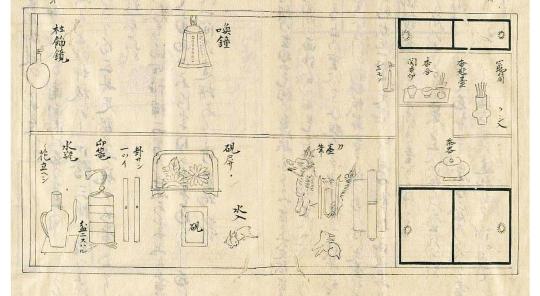
5) The arrangement of objects on the dashi-fuzukue (tsuke-shoin), and its associated chigai-dana¹⁶.
On the side of the sketch showing the chigai-dana, the writing on the sketch reads (from right to left): kuji-zutsu [鬮筒] (a vessel intended to hold the bamboo slips used for one system of Chinese divination¹⁷), below which is written kuji irete [クシ入], which means that “the kuji should be put into" the kuji-zutsu (when it is displayed on the chigai-dana -- the small lines extending upwards from the kuji-zutsu are supposed to represent the kuji); and on the tray, on the upper shelf of the chigai-dana, a kō-saji dai [香匙臺]¹⁸ (a small, vase-like stand in which the incense implements are stood), a kōgō [香合]; and a kiki-kōro [聞香爐] (a small censer that is held in the hand when sniffing incense); and below, a chaki [茶器] (the traditional Korean word for a chaire -- as cha-tsubo [茶壺] is the Chinese word).
On the dashi-fuzukue (the tsuke-shoin, or built-in writing desk): (hanging on the right pillar) shumoku [シユモク = 撞木] (a wooden hammer-like striker with which the hanging kanshō is sounded); katana [刀], sumi [墨], fude [筆] (the three implements -- a paper-knife, an ink-stick, and a writing brush -- leaning against the hitsu-ga [筆駕], brush rest, which is shaped like a kirin [麒麟], a mythical beast resembling a cross between a deer and a giraffe); a mizu-ire [水入] (shaped like a rabbit); a kenbyō [硯屛] (a miniature standing screen, usually made of pottery, that keeps dust from blowing onto the suzuri -- inkstone); (above) kanshō [喚鐘] (a hanging bell); suzuri [硯] (inkstone); kesan [卦サン = 卦算] (metal paperweights), with the comment hitotsu i [一ツイ], “just one [will suffice];” an inrō [印籠] (a lacquered case for carved name seals and seal-ink); a sui-bin [水瓶]¹⁹, with the comments (on the right) bon ni suwaru [盆ニスハル花立ヘシ] (sitting on a tray), and (on the left) hana tatsu-beshi [花立ヘシ] (it is best if a flower is stood [in the sui-bin]²⁰); (and suspended from the pillar on the left) hashira kazari-kyō [柱飾鏡] (a decorative mirror²¹ displayed on the pillar).
Regarding the arrangement of the objects on the shoin, Sōami wrote: “with respect to the way to decorate the shoin, first the ken-byō [硯屛] (a small screen that protects the ink stone from dust), and second the suzuri [硯] (ink stone) should be placed out. Then, carefully considering the distance between them, the fude-kake [筆架] (brush rest) is placed, and next the mizu-ire [水入] (water dropper); next, the jiku-mono [軸物] (scroll); then the inrō [印籠] (box of name-seals and ink); next the kesan [卦算] (paperweights); next the sui-bin [水瓶] (a water bottle, here used as a flower vase): in every case, whether front to back or side to side, these things should be placed in the middle of the [space available on the] oshi-ita²²; only the suzuri is correctly placed in front of the ken-byō (that is, centered between the ken-byō and the front of the desk).”
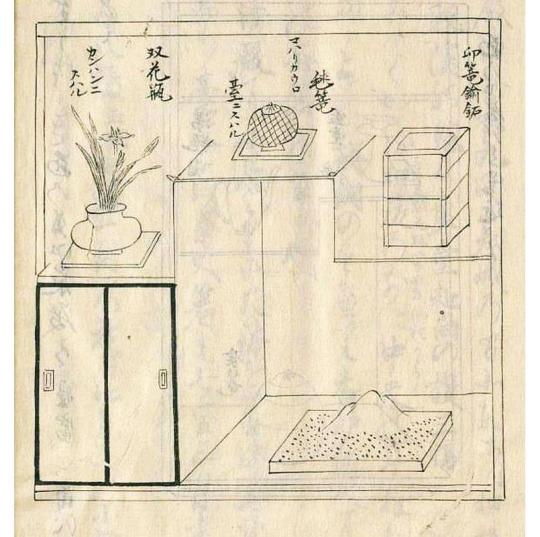
6) Another arrangement for the chigai-dana. From the right, the writing reads: inrō chūseki [印籠 鍮鉐] (an inrō [印籠] made of Mogul brass)²³; a kyūrō [毬籠] (a ball-like incense burner), beside which is written mawari-kōro [マハリカウロ] (a censer that perfumes the air in the room), and the comment dai ni suwaru [臺ニスハル] (sitting on a stand)²⁴; a sō-kabin [双花瓶] (a flower-vase for a more formal flower arrangement -- as opposed to a single flower), with the comment kanban ni suwaru [翰盤] (sitting on a kanban [カンハンニスワル], which is a sort of lap-table used for writing).

7) A fourth arrangement for the chigai-dana. The objects displayed are: (above, from right to left) a yu-bin [湯瓶] (a usually bronze handled pitcher for hot water -- this object was used when serving usucha in the Chinese manner²⁵); a sakazuki [盃]²⁶ resting on a dai [臺], which assembly was then displayed on a tray (bon [盆]).
(Below) a jikirō [食籠] (a lidded box for sweets or side-dishes -- this one may consist of several layers that stack one on top of the other).

8) Here a portable chigai-dana (which the commentary states was made of shi-dan [紫檀], red sandalwood) has been placed on the oshi-ita, located in the north-west corner of the room, and on the wall above it a pair of small scrolls have been hung.
The shōji [障子]²⁷ featured a painting of autumnal flowers.
The objects displayed on the tana are: (above) a kabin [花瓶] (flower vase) on a small tray²⁸; (in the middle compartment, from right to left) a kagami [鏡] (bronze mirror), and a kōgō [香合] on a small tray; (and below) a cha-ki [茶器] (tea container)²⁹ [decorated with] zōgan [象眼] (mother-of-pearl and ivory inlay), and (on the shelf) the “Kaeri-bana” chaki [歸花茶器]³⁰, in its fukuro, and [resting] on a small tray.

9) Another arrangement for the chigai-dana. A Kantō-mizuhiki [カンタウノ水ヒキカヽル] (an embroidered valance from China)³¹ is hung (across the top of the opening).
The objects displayed on the chigai-dana are (from the right) a yu-bin [湯瓶] (a bronze pitcher for hot water), and a sakazuki [盃] (saucer for drinking sake) on a dai [臺]; and (below) a pair of hone-haki [骨吐]³², tsui-kō horimono [堆紅彫物] (of carved tsui-kō lacquer).
Sōami also notes that the shōji (the sliding doors of the cupboard beneath the lower shelf of the chigai-dana) bore a painting of the scenery to the southeast of Kyōto (“from Ishiyama [石山] to Seta [勢田], and onward to Ōtsu [大津]” at the southern end of Lake Biwa)

10) This is an arrangement of objects on the dashi-fuzukue (tsuke-shoin). From right to left, a hossu [拂子] (a sort of horse-hair whisk with which monks -- usually of high status, since these tended to be expensive objects -- brushed away insects rather than killing them; and which became a sort of status symbol among the members of the monastic communities) is hung on the right-hand pillar; above is a tsuri-kōro [釣香爐] (a hanging censer)³³, while below on the writing desk are three ishi-bachi [石鉢] (“viewing stones” -- natural stones whose shape suggests scenes from nature -- arranged in basins of granite sand); and, suspended from the left pillar, a Dōjaku-dai to-iu kagami [銅雀臺ト云鏡] (a bronze mirror that is said to have a scene of the “Dōjaku-dai” -- “the Bronze Sparrow Terrace” -- on the back side)³⁴.

11) This chigai-dana featured a pair of small shōji in the upper wall (for ventilation).
The objects on the shelves are, from right to left, a tsui-kō jin-bako [堆紅沈箱] (a carved lacquer box in which a selection of pieces of wood incense were kept)³⁵; and a kōsaji-dai [香匙臺] (a small, vase-like container in which an incense-spoon and a pair of ebony incense chopsticks were stood), kōgō [香合] (in this case, the kōgō probably contained only the gin-yō [銀葉] -- mica squares on which the pieces of incense wood were burned), and kōro [香爐] were arranged, with the accompanying note san-shoku bon ni suwaru [三色盆ニスハル] (which means “the three objects all are sitting on the tray [together]”)³⁶; and below is placed a cha-ki [茶器]³⁷.
The painting on the shōji featured a scene of a summer landscape, according to Sōami’s notes³⁸.
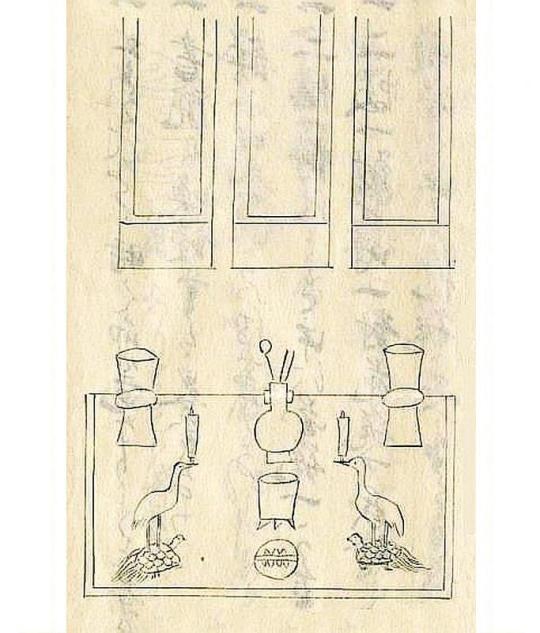
12) An arrangement for the table placed on the oshi-ita in front of a triptych. This arrangement of the full set of objects is referred to as moro-kazari [もろかざり = 諸飾]³⁹.
The following kaki-ire [書入] was appended to the sketch (perhaps by the original author, Sōami): yo no tsune no kyaku kuru nado ni ha kazarazu; o-nari ha mochiron nari; ika ni mo shōgan⁴⁰ no koto nari; kono soto ni ittsui hana waki ni aru-beshi [よの常の客来るなどにはかさらす。御成は勿論なり。いかにもしやうくわんの事なり。此外に一對花わきにあるへし]: in the case of the more ordinary guests and the like, [the oshi-ita] should not be decorated in this way⁴¹. But when one receives a visit from ones lord, naturally [this arrangement should be employed]. Indeed, the purpose [of this arrangement] it to show [ones] appreciation [for the lord's visit]. A pair of flower [arrangements] should be placed outside [of this table]⁴².
__________________________
¹The date of publication of the block-printed facsimile edition, while clearly of early Edo period vintage, is unknown. The copy is preserved in the Waseda University collection, along with a second manuscript version of the text (which is dated 1762). This subsequent document is titled Higashiyama-dono O-kazari Sho [東山殿御飾書], with the authorship ascribed to Sōami. While generally similar to the block-printed version, the modifications (especially the kaki-ire [書入] additions to the original text) seen in this second edition reflect Edo period preferences and practices. The block-printed edition will be discussed below.
The material included in Book Four of the Nampō Roku shows a closer connection with the O-kazari Ki / O-kazari Sho than to Nōami’s treatise.
²A convincing case could be made for the argument that Sōami's purpose was simply to produce an edited (and updated) version of the Kun-dai Kan Sa-u Chō Ki.
³In other words, this is a permanent oshi-ita, the immediate precursor to the tokonoma (which combined the functions of the oshi-ita with that of the nobleman's mi-chōdai [御帳臺]). An “old style” oshi-ita (made from a Korean table with the legs folded into the box-like top) is considered in the last illustration.
⁴These four scrolls were either originally a single large painting that was cut into parts (to make conservation easier and safer), or a set that was always intended to be hung together (whether by the artist who created the works, or by the dōbō [同朋] who collected them together in Japan). In any case, they are hung up as if they were a single work, starting with the scroll on the side where the painting begins, and ending with the painting (which includes the principal colophon, and the artist's signature and name seals).
In the corresponding plate in the O-kazari Sho [御飾書], the four thumbnail sketches are replaced with the numbers “一 二 三 四” (1, 2, 3, 4), to indicate the order in which the scrolls should be hung.
⁵Kodō [コトウ] means kodō [胡銅], a form of bronze that turns nearly black with age. It is found among both Chinese and old Korean pieces.
⁶Ko-bon nose [小盆載]. The verb noseru [載せる] means to place on (something).
The question here, however, is concerned with the small tray. Jōō is said to have created the small tray for the chaire (according to Rikyū's account, by “dividing the naga-bon in half”); but, since Sōami wrote the O-kazari Ki in 1523 (when Jōō was only 21 years old, and had not really commenced with his study of chanoyu yet), this idea of arranging a chaire on a small tray (when displayed as a decorative object in the shoin) clearly predates Jōō's usage.
What Jōō actually did was: fix the size of the small tray as a function of the size of the chaire that would be placed on it; and, use the small tray as the base for the chaire (and chashaku) during the service of tea. In Sōami's day (and, of course, before), while the chaire was sometimes displayed on a small tray on the chigai-dana, as here*, during the temae it was placed on a naga-bon. In chanoyu very few things are ever truly original: most things are variations of things that were done before, modified toward new ends.
__________
*The display of the temmoku and the chaire on the chigai-dana is similar to arranging these things side by side on the naga-bon, but with an important difference: here the chaire is clearly shown to be inferior to the dai-temmoku (in which tea will be served to the shōkyaku) by displaying it on a lower level.
In the gokushin-temae, too, this difference is underscored. The temae begins with the host concentrating his attention on the temmoku-chawan, and it is while the bowl is being warmed (with the chasen resting in it) that the host removes the shifuku from the chaire, cleans the naga-bon and then it, and places it on the naga-bon; after which the chashaku is also cleaned and rested on the tray. This is followed by the chasen-tōshi. While this procedure can be understood as a way to protect the tea as long as possible (the tension is not released from the lid of the chaire until much later in the temae than we would find usual), the fact is that the chaire was always considered inferior to the chawan until the advent of wabi-no-chanoyu, and its focus on showing respect to the utensils.
In the early days, a chawan was used only until it began to be stained by the tea. Once stains became apparent (such as by darkening the crackles in the glaze), the bowl was discarded and replaced by a new one. The chaire, on the other hand -- like the cha-tsubo -- became “better” the longer it was used, since the volatile components of the tea infiltrated into the clay, meaning that, over time, the jar had less and less of a negative impact on the taste and aroma of the tea that it contained (this, however, is why the rule was that the host should always use the same blend of tea -- since shifting blends would result in cross-contamination of the new tea with elements from the old that volatilized from the inside of the jar: in the early days, both the cha-tsubo, and the chaire, were not glazed on the inside).
This idea of “better,” however, while understood in the early days, did not figure into the aesthetic assessment of the chaire: when viewed as art-objects, the classical chaire were simply not in the same class as the yō-hen [窯變] and yu-teki [油滴] bowls selected for use as chawan (which, in addition to their inherent aesthetic appeal, usually sported a fukurin [覆輪] of gold around the rim of the bowl).
⁷Katatsuki-tsubo [肩衝壺]. The word “chaire” [茶入] was used primarily by the machi-shū practitioners of wabi-chanoyu (probably so as to avoid confusion between the small tea container and the large storage jars for leaf tea).
Sōami follows the continental practice of referring to the tea container as a “cha-tsubo” [茶壺]. This is the term used in the Hyakujō Shin-gi [百丈清規] (the first Chinese treatise that mentions the drinking of matcha, and which some scholars claim -- apparently ignorant of the actual contents of this book -- is the origin of chanoyu): this work sets out the set of monastery regulations (including those related to the drinking of tea by the monks on special occasions, such as the Emperor's birthday*) said to have been proposed by the great Chán master Baizhang Huaihai [百丈懐海; 720 ~ 814] (his name is pronounced Hyakujō Ekai in Japanese).
__________
*Tea apparently was given to the monks as a sort of treat -- though it was prepared for them by the kitchen staff who set up a table behind the altar in the Buddha Hall of the temple, bringing a pitcher of hot water from the kitchen for this purpose. The book details how the monks rise from their seats and proceed to enter the space behind the altar from one side, where they drink their tea perfunctorily, and then return to their seats by emerging from the other side. There are no rules about how the tea is made -- though apparently this was done assembly-line style, in the same way that food was given to them in the dining hall -- nor is anything said about how it is to be drunk.
Drinking matcha does not mean -- and must not be equated with -- chanoyu, except for those people who wish to predate the appearance of chanoyu in Japan to some point before 1403 (which is when the practice was introduced to the court of the shōgun by the nobles escaping from the collapsing Koryeo dynasty).
⁸These things are (in back, from right to left) a candlestick, a kyōji-tate [香筋建] (a vase-like container for the implements used when placing incense into the censer), and a flower vase; and (in front) a kōgō [香合] (incense container).
⁹See footnote 8 in the part of the previous post dedicated to the Kun-dai Kan Sa-u Chō Ki [君臺觀左右帳記] for a discussion of the ukai-chawan [迂回茶碗].
¹⁰Hō-bon ni nose [方盆ニ載]. This sentence seems to have been miscopied here. The pair of ukai-chawan are placed on a square (or rectangular) tray, not the jikirō. This sketch reproduces one found in the Kun-dai Kan Sa-u Chō Ki.
¹¹Kenzan mutsu kaku-dai ni suwaru [建山六ツ各臺ニスハル]. The first word in this phrase is Kenzan [建盞], which means sakazuki [盞] (conical cups for drinking heated “rice-wine”) from Fujian (abbreviated Ken [建]). The kanji san [山] should be understood as a hentai-gana (for the sound san/zan).
¹²Juro-no-habōki [ジユロノ羽ホウキ]. Juro [棕櫚] is the hemp-palm, and in the modern tea world, one version of the broom used to sweep the roji is made from several dried palm fronds tied to a handle of green bamboo (this kind of broom is called a juro-bōki [棕櫚箒]).
Juro-no-habōki could either mean that the habōki is made from a dried palm frond that has been trimmed and combed into fibers (possibly the kanji ha [羽] was added by mistake when the sketch was copied); or, possibility this means a habōki made not from one or three feathers, like nowadays, but from the entire wing of a small bird. Today this kind of habōki (which is usually made from the wing of a swan or crane) is usually known as a haki-komi [掃込]: this kind of feather-duster resembles a broom made from a dried palm frond. In Furuta Sōshitsu’s writings, however, it seems that a smaller version was still being used as a temae-habōki in his day.
In Nōami's sketch, the “juro-no-habōki” looks like a small haki-komi (though whether it was actually made from a hemp-palm frond, or from the wing of a bird, is not specified -- and the kaki-ire stating the name is missing).
¹³Hi-kaki [火カキ = 火掻き] is a sort of spoon-shaped fire-iron used to rake the ashes in the furo. Once again, since the kama on the o-chanoyu-dana was kept boiling all day, as the charcoal burned down the ashes would have to be raked flat so that fresh fuel could be added, and this is the implement that was used.
The hi-kaki seems to have been a combination of a hai-saji [灰匙] and a soko-tori [底取] (while modern furo-yō soko-tori [風爐用底取] is shaped like a shallow soup ladle, Rikyū's soko-tori was shaped like a large hai-saji). In Nōami's sketch, the hi-kaki resembles a large hai-saji.
¹⁴The source of the sketches is a manuscript that was passed down in the Imai family, and probably hand-copied by a member of that house. (Sōami's original is not known to exist.) Since the Imai family was prominent among the teamen of the sixteenth century, it seems likely that, when confronted by sketches of things that did not really make sense, they were interpreted through the eyes of a machi-shū chajin. This could also account for the similarity of the juno-no-habōki with an ordinary temae-habōki.
¹⁵The placement of the sumi-tori on the right, and the koboshi on the left may be an anachronistic emendation. Neither of these things are shown in Nōami's sketch.
¹⁶Note that the original sketch extends across two pages in the Imai manuscript (which was copied into a notebook), with a break in the middle. I have digitally removed the space that separated the two halves of the sketch from each other so that the sketch now resembles the presumed original (which was most likely written on a horizontal roll of paper).
¹⁷The modern equivalent, called mikuji [御籤, or 神鬮], are small strips of paper bought at Shintō shrines, with a fortune written on them. They are usually sold from a vending machine.
In the Chinese practice, however, the tube containing the bamboo strips (which are known as qiān [籤]*) was held almost horizontally by the querent and shaken until one slip falls out, thereby revealing the answer to the user's question.
__________
*While it seems that in ancient times a brief augury was written on each bamboo slip, more recently each of the slips is numbered, the number pointing to a specific text recorded in a book of prognostications (the statements are usually ambiguous -- often in verse -- and generally require the help of an expert to relate the meaning to the specific question that was asked).
This form of divination is known as Qiú-qiān [求籤] in Chinese. The qiān-tong [簽筒] (the tube out of which the bamboo slip is shaken) is equivalent to what Sōami calls the kuji-zutsu [鬮筒] here.
¹⁸This vessel is called a kyōji-tate [香筋建] today.
A kō-saji [香匙] is a long-handled spoon used to pick up pieces of incense wood, when moving them from the cutting block to the kō-zutsumi [香包み] (a small cloth envelope lined with gilt paper), which is, in turn, put inside the kōgō. The kyōji [香筋, or 香箸] (ebony chopsticks) are used when transferring the incense wood from the kō-zutsumi into the kōro.
The idea is that the incense wood should never be touched with the fingers -- since the skin oils could effect the smell of the incense.
In the sketch, the kō-saji and kyōji are shown standing in the kō-saji dai (kyōji-tate).
¹⁹Sui-bin [水瓶]. This kanji compound can also be pronounced mizu-kame.
²⁰Hana tatsu-beshi [花立ヘシ]: a flower should be stood [in the sui-bin] -- perhaps so that the guests do not mistakenly suppose the water is a refreshment, and drink it.
²¹These were imported bronze pieces, usually from China, and probably antiques. Though they could be used for looking at oneself, the primary purpose here is decorative. This is what the kaki-ire implies.
²²Perhaps a miscopying. The objects are to be centered, front to back and side to side, on the surface of the writing desk.
²³Inrō chūseki [印籠 鍮鉐] means an inrō (a set of boxes in which carved name-seals and seal-ink were kept), made from chūseki [鍮鉐], which seems to be the kind of brass produced in Mogul India. Thus, a set of stacking brass boxes imported from India (probably via China or Southeast Asia), that were used as an inrō in Japan.
Chūseki is usually known as ōdō [黄銅] today, and the classical term has been lost from the East Asian languages.
²⁴Kyūrō ・ mawari-kōro ・ dai ni suwaru [毬籠 ・ マハリカウロ ・ 臺ニスハル].
A kyūrō [毬籠] would be a kind of hanging incense burner, made of openwork metal, usually made with a series of concentric brackets inside, attached to each other at 90°, and with a cup in the middle. The brackets allow the cup to remain upright even when the kyūrō is shaken by the breeze. A pinch of crushed incense wood was placed in the cup, and set to smoldering with a taper. This kind of censer was used to perfume the often fetid inner-city air blowing into the upper story windows from the street. Both Chinese and Mogul examples exist.

The word kyūrō, as it is written here, could also mean a basket in which a gauze bag of dry aromatics was kept, for the purpose of perfuming the air in the room. In either case, when not suspended from the ceiling, this kind of kōro could be provided with a base (as shown above*), allowing it to be placed on a shelf (as in sketch 6).
Mawari-kōro [マハリカウロ = 周り香爐] seems to mean a censer that is intended to perfume the air in the room (mawari [周り] means “in the vicinity”).
In addition to the more elaborate system explained above, which was intended to facilitate the burning of crushed incense wood, some commentators state that a cloth bag, in which a blend of aromatic herbs and fragrant wood chips were tied, was placed inside the censer, to perfume the air of the room passively (in other words, without the incense being burned), and over a long period of time†. The point here was to perfume the air of the room without the source of the fragrance being obvious.
Dai ni suwaru [臺ニスハル = 臺に座る] means that the kyūrō is sitting on a specially made stand (rather than being suspended from the ceiling, which was the other way such censers were displayed). In the sketch, the dai is not obvious: the word dai does not refer to the tray on which the kōro (resting on the dai) is displayed.
___________
*Though this dai was not always as elaborate as the one shown. Some resemble a downward-facing bottle-cap -- a metal ring that flares outward slightly at the bottom.
†While the use of such sachets (called kariroku [訶梨勒], an Edo period drawing of a rather modest example of which is shown below) had been known since the Heian period -- kariroku were often hung up to perfume the interior of the nobleman’s mi-chōdai [御帳臺] (an elevated platform usually covered with two tatami mats, with a cloth canopy above and curtains or reed blinds suspended around the four sides: it functioned as the nobleman’s seat of estate during the daytime, and as his bed at night) -- the sachets themselves were usually made of beautiful cloth, and adorned with exquisitely tied knots, and so were decorative objects in their own right.

In fact, have never seen any classical reference that mentions secreting these sachets inside of censors of the type that are under consideration here.
²⁵The original Chinese way of serving tea was for a scoop of matcha to be placed in the temmoku (resting on a dai). This was then held out while the servant poured in some hot water and whisked the usucha with a chasen.
This is the method of service that is mentioned (albeit briefly) in the Bǎizhàng Qīng-guī [百丈清規] (Hyakujō Shin-gi, in Japanese -- which is also mentioned in footnote 7, above), and employed in the Kennin-ji yotsu-gashira-shiki sarei [建仁寺 四頭式茶礼] (which is performed at the Kennin-ji in Kyōto every year on April 20th, the memorial day of Myō-an Eisai Zenji [明菴榮西禪師; 1141 ~ 1215]).
²⁶The kanji is hai [盃] (this kanji can also be pronounced sakazuki), which means a shallow, saucer-like vessel, usually made of lacquered wood, from which heated sake was drunk. This is a different word from san [盞] (which can also be read sakazuki), which means a conical ceramic cup (or “bowl”), also originally made for drinking hot sake. Sake, usually flavored with medicinal herbs, was a popular drink in both China and Korea in ancient times. Distilled spirits, of the sort we usually associate with those cultures today, did not appear until much later.
The hai, resting on a dai, must not be conflated with a temmoku resting on a dai (which some scholars apparently have done, on account of the yu-bin being displayed on the lower shelf). In general, the intention behind these arrangements seems to be to avoid anything that would resemble a smörgåsbord: the bronze pitcher used (in China) to serve tea is displayed together with a shallow saucer used to drink sake.
²⁷In this case, the word shōji [障子] refers to the sliding doors on the tana.
²⁸Because the bottom of classical bronze pieces had to be added after the piece was cast (they were cast as cylinders, with both ends open), the weld was not always completely watertight* (though pieces that leaked badly rarely made it to market). As a result, flower containers were placed on small trays, to prevent any leakage from damaging the shelf†.
__________
*While considered great treasures in Japan, where the technology of bronze making was as yet unknown, it seems that most of these pieces were rather commonplace in their countries of origin (in both China and Korea, people of all classes worshiped their ancestors at least on certain occasions during the year, and, as this required a special set of implements, including flower vases and candlesticks, the range in prices was staggering -- and it was naturally items at the lower end of the spectrum that speculators bought for export to Japan, since the rarity of bronze of any sort in Japan meant that such things would yield the greatest profits). As a result, minor leaks would have been found from time to time -- and apparently often enough that taking the precaution of displaying the vase on a tray was deemed prudent.
†Many of the pieces employed as mizusashi in Japan were made as containers for the alcoholic beverages that were used for libations during ancestor-worship ceremonies, and these vessels were usually lined with lead during the production process (molten lead was poured into the finished vessel, and, after rotating the piece so as to coat all sides, the excess lead was poured out), to render them completely watertight.
It seems that a similar degree of care was not deemed necessary with respect to flower vases.
²⁹Probably a copying error.
In the O-kazari Sho [御飾書], this object is labeled as a jikirō [食籠], a lidded container for sweets and side-dishes that were served to accompany tea or sake.
It is unlikely that more than one chaki [茶器] would be displayed at the same time, and the famous Kaeri-bana [歸花] tea container is displayed on the shelf to the left.
³⁰In the Kun-dai Kan Sa-u Chō Ki this piece is referred to as the Kaeri-bana yakki [歸花藥器]*, and the sketch of this object (which was used as a tea container) is shown below. It seems to have been made of carved lacquer, and, while this point is not discussed in any of the classical writings, cinnabar lacquer (tsui-shu [堆朱]) seems more likely than black. Below the sketch from the O-kazari Ki is shown beside the kind of container that was described in that work (while this container and the tray on which it rests is referred to as a bon-kōgō today, this naturally does not preclude the likelihood of its having had a very different function in antiquity).

The word kaeri-bana (whether written “歸花,” or “反花”) means a flower that blooms out of season -- especially spring flowers (such as the cherry) that bloom in the late autumn or early winter, before the arrival of the intensely cold weather†. The reason why this container (which is a stylized lotus blossom, with the carpellary receptacle at the top, and several rows of petals below) was given this name is not explained in any of the classical sources.
__________
*The name was also written Kaeri-bana yakki [反花藥器]; and sometimes the phonetic rendering sori-bana [ソリハナ] is found (in place of kaeri-bana) in the old writings.
†Flowers that bloom later the same year, after the season is past (especially, cherry-blossoms blooming in early summer), are usually referred to as yoka [餘花 -- usually written 余花 today].
³¹Kantō-mizuhiki kakaru [カンタウノ水ヒキカヽル]* is a miscopying for Kantan-mizuhiki kakaru [カンタンノ水ヒキカヽル], which means "a mizu-hiki (a Chinese-style valance made of heavily embroidered cloth that kept rain water from blowing in through the transom windows) from Hándān [邯鄲] (pronounced Kantan in Japanese)† is hung up."
Today the word mizuhiki [水引] refers to the red-and-white‡ (or black-and-white**) paper cords tied around gifts and gift-envelopes; and, less commonly, to Persicaria filiformis, a wildflower with long racemes of tiny red or white flowers (that poetically resemble dew-drops scattered along the stem). These usages have no connection with the present entry -- though they appear to have confused a number of scholars.
__________
*Kantō [カンタウ] has been interpreted by certain scholars to be kantō [漢渡], “crossing over from China” (though the more natural interpretation, kantō [韓渡], meaning “crossing over from Korea,” is patently ignored), in the same way that the generic name for stripped cloth is generally understood to imply a Chinese origin for these textiles. In fact, there is no historical evidence for such usage prior to the sixteenth century (where a Korean origin seems to have been understood) or later (when the implied source was supposed to be China).
†Hándān [邯鄲] remains a major city in Héběi [河北] province, and was the capital of the State of Zhào [趙] during the Warring States period (c 475 BC ~ c 249 BC) of Chinese history.
In Japanese, kantan [邯鄲] is also the name of the tree cricket (Oecanthus longicauda), but this meaning is irrelevant here.
‡Used on felicitous occasions -- New Years, O-bon, birthdays, weddings, and so forth..
**Used on sad occasions, such as funerals.
³²Hone-haki ittsui [骨吐一對] literally means “a pair of [containers for] spitting-out bones” (or, perhaps, “a pair of spittoons”), and such receptacles were probably used for such a purpose on the continent. In Japan, however, they were used as decorative pieces (the pair in question were made of tsui-kō [堆紅]*).
Smaller (and simpler) versions were used as mizu-koboshi (Rikyū's mon-sasu koboshi [モンサスコホシ] was a low-fired pottery version of this kind of container).
__________
*These hone-haki are described as tsui-kō horimono [堆紅彫物], carved objects of tsui-kō.
Tsui-kō [堆紅] is one of several Chinese varieties of carved lacquer. In this case, thick layers of black and cinnabar lacquer are applied alternately, with the final layer being cinnabar. The carving is done through the layers, and while this presents a striped effect when viewed close up, from a distance it darkens the carving dramatically (without making the decoration appear to be a solid black, and so look painted-on).
³³This basket-like hanging incense burner is recorded to have been made of silver. While it is possible that crushed incense wood was burned in a cup in this type of censer as well, this one more likely contained a kariroku [訶梨勒], a blend of dried aromatic plants tied in a gauze bag, intended to perfume the air in the manner known as sora-daki [空薫] -- “without revealing the source of the fragrance.”
As mentioned above, the idea of burning incense in the window well came from the continent (this usage was known from both India and China), where opening the windows on the upper stories in the densely populated urban areas would let in fetid air, which the incense was intended to mask (while still letting in the cooling breezes).
³⁴This mirror featured a bas relief of what was said to be the Dōjaku-dai [銅雀臺] (“Bronze Sparrow Terrace”), the legendary mansion of the great Chinese military strategist Cao Cao [曹操; c 155 ~ 220] of the Three Kingdoms Period (Sānguó Shídài [三國時代], c 220 ~ 280 AD).

The type of mirror in question is shown on the right, while the scene was probably similar to the painting (of the same Tóng què tái [銅雀臺]) on the left.
³⁵A jin-bako [沈箱] is a box in which a selection of pieces of incense wood was kept: rectangular boxes, such as the one shown in this sketch, are said to have had six small compartments inside, while round boxes typically had seven (arranged like six petals around the center). The incense, previously cut into pieces of a size suitable for burning in a kiki-kōro [聞き香爐] (a hand-held censer used for sniffing incense), would have been kept in small kō-zutsumi [香包み] (envelopes made of donsu cloth backed by gilded paper -- the gilding helping to keep the volatile components inside the envelope, so that the different varieties of incense would not contaminate each other).
The present box was made of tsui-kō [堆紅], a variety of carved lacquer where the piece was coated with alternating layers of cinnabar and black lacquer, with the final coat being red*. Carving through the lacquer revealed a striped pattern.
__________
*When the final coat was black, the lacquer is referred to as tsui-u [堆烏]. Both types were popular during the Ming period.
³⁶San-shoku bon ni suwaru [三色盆ニスハル]. Shoku [色] -- which literally means “color” -- was used as a counting word, in the classical period, to subdivide collections of similar things into groups. Here, all three objects are utensils that are used when appreciating incense: that is their common identity.
In Book One of the Nampō Roku, the expression is used to differentiate flowers into their two logical groups -- herbaceous flowers (which bloom near the ground), and the flowers of trees (which bloom above eye-level).
I am mentioning this once again here because it seems many Japanese scholars take the word shoku literally, and try to make it mean “colors.”
In the present instance this would clearly be nonsensical; but in the example in Book One, doing so leads to the enunciation of a false teaching -- that only one or two colors of flowers are permitted in the tearoom at the same time (what Rikyū was actually saying there is that, in the small room, only one type of flower -- herbaceous flowers*, or flowers cut from trees† -- should be used; but when the room is increased to 4.5 mats, then both herbaceous and the flowers from trees may be used together in the same arrangement, as they always are in the formal rikka [立華] arrangements, which he was using as his precedent).
__________
*Herbaceous flowers, which naturally bloom near to the ground, should (according to him) be arranged in a vase standing on the floor of the tokonoma.
†Because the flowers of trees are encountered above eye-level in nature, the look most natural when arranged in a vase hung on the hook nailed into the back wall of the toko. Indeed, according to the poem written by Jōō (and later modified by Rikyū) the height of this hook is decided upon relative to the height of the guests' eyes when they are seated appropriately in front of the tokonoma -- so that the flowers arranged in the hanging vase will be slightly above their eye level. In this way they will look natural, since they will be seen in exactly the same way that one would encounter them in nature.
³⁷Chaki oite [茶器置]. This is another instance of miscopying. The word given as chaki [茶器] should be yakki [藥器], which, in this case, means a (decorative) medicine case.
The person who made this copy was clearly a chajin, and the result is that he saw references to tea and tea utensils even in places where they were not to intended.
³⁸O-shōji no e [御障子の繪]. Shōji here refers to the pair of sliding doors that enclose the ji-fukuro, below the chigai-dana.
According to one source, the last word is sumi-e [墨繪], meaning a painting in black ink only. It seems that many of these doors were covered with antique paintings from the shōgun's collection of imported works. Perhaps these were from scrolls that had been damaged, with the ruined parts cut away, and the remainder used for purposes such as this.
³⁹Moro-kazari [もろかさり = 諸飾り]. While the tea schools have modified the meaning of this expression to a certain extent, it originally signified the arrangement of the full set of implements* -- an incense burner, a pair of vases, and a pair of candlesticks -- on a table that was placed in front of the triptych.
This was done only for the most formal of receptions, however. On more ordinary occasions, the things displayed on the joku [卓] were reduced in number to what is referred to as the mitsu-gusoku [三具足] -- one flower vase, one candlestick, and the censer.
___________
*In addition to the things mentioned above, a kōsaji-dai [香匙臺] and a kōgō [香合] have been added to the standard set.
⁴⁰Shō-gwan [しやうくわん] is the actual sound that is rendered phonetically here. In the modern language, the sound has been contracted to shōgan [賞翫].
The word shōgan means appreciation, admiration, and enjoyment (in the sense of enjoying the honor of receiving a visit from ones lord).
⁴¹The objects on the table in front of the oshi-ita should be arranged as was shown in sketch 3, “the ordinary way to arrange the oshi-ita when a triptych is hung” -- which is a simplified version of the full arrangement shown in sketch 12. The fact that this sketch was included at the end of the manuscript, almost as an afterthought, suggests that the full arrangement was secret, and to be used only on the rarest of occasions.
It is worthy of note that this sketch was moved to the very front of the work when it was prepared for the officials in charge of the arrangement of the Tokugawa shōgun’s shoin. That version of Soami’s work is what has come to be known as the O-kazari Sho [御飾書] -- and its sketches will be considered (in reference to the O-kazari Ki) next.
⁴²Kono soto ni ittsui hana waki ni aru-beshi [此外に一對花わきにあるへし]. This refers to the pair of flower arrangements (the vases are seen in sketch 3) that are placed (on their own stands) on the right and left of the central table. The left and right arrangements were formal rikka [立華], while those on the central table were simpler (in keeping with the smaller size of their vases, and the confines of the table itself -- these smaller arrangements should not project beyond the edges of the table on which the vases stand).
==============================================
◎ O-kazari Sho [御飾書], while also ascribed to Sōami, seems to be an Edo period revision, intended to relate this material more specifically to the arrangement of the various shoin within the Tokugawa shōgun’s residence in Edo. As such, the order of the material has been changed, to a certain extent, while extraneous comments have also been interpolated from time to time¹.
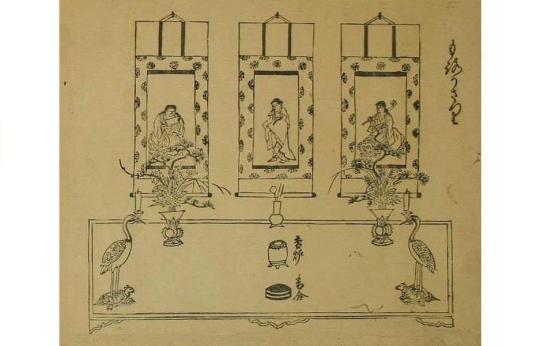
1) The first sketch has been transposed from the end of the O-kazari Ki, to the beginning of the O-kazari Sho (indeed, it has been placed in the middle of the enumeration of the various utensils that were displayed in the shoin, being found between illustrations of the various hai-gata appropriate for the kōro, and an illustrated list of the different shapes of the classical chaire). The text of the kaki-ire that explains the use of this arrangement (see the commentary under sketch 12 in the O-kazari Ki) has been clarified, so as to avoid any confusion².
Notice, however, that the positions of the candlesticks and flower vases have been reversed from what was shown in the O-kazari Ki.

2) This plate corresponds to sketch 1 in the O-kazari Ki. The commentary repeats the material translated under that entry.

3) This plate is not found in either the O-kazari Ki, or the Kun-dai Kan Sa-u Chō Ki.
The kaki-ire appended to this sketch reads: joku no ma mo joku no ma mo yoku sun wo torite onaji hodo oku-beshi [卓の間も卓の間もよく寸をとりて同ほとに置くへし], which seems to mean “the space between the table (and the wall?), as well as between the table (and the other wall?), should be carefully noted, so that (the table) will be placed (in such a way) that these are approximately the same.” This would seem to mean that the space between the table and the wall at the rear of the oshi-ita (which is fixed, based on the depth of the oshi-ita, since the joku should be centered between the rear wall and the front edge of the alcove), and between the table and the side wall, should be essentially equal.
Though this is also the text found in the Higashiyama-dono O-kazari Sho [東山殿御飾書] (which manuscript is dated 1762, and appears to have been copied from the original document that was preserved in the shōgun's household), some scholars have suggested that the second phrase should be habikori no ma mo [衍の間も], which would then mean “the space between the table (and the wall)³, and the extent to which (the arrangement) spreads beyond (the table) should be taken note of, so that these are approximately the same.”

4) Though dissociated from the picture of the dashi-fuzukue, this plate shows the arrangement of the chigai-dana found in sketch 5 of the O-kazari Ki. There, however, seem to be several anomalies here: the objects displayed on the tray (on the upper shelf of the chigai-dana) are labeled (from the right) kōsaji・hi-saji [香匙・火匙] (these are placed together in the vase-like holder, but it is not clear what a hi-saji might be -- the original showed a kōsaji [香匙] and a pair of kyōji [香筋], ebony chopsticks, in what Soami described as a kosaji-dai [香匙臺]), kōro [かうろ・香炉] (the name is written phonetically and then with kanji), and a kiku-kōro [きく・聞香炉] (the kana kiku are written as furigana; though this object is usually called a kiki-kōro [聞き香炉]). However, the biggest problem is with the utensil in the middle: in the original, this is a kōgō [香合], not a koro [香炉]. Below the upper shelf, the word bon・kata-bon [ぼん・かた盆] (with the kana bon [ぼん] as furigana showing the pronunciation of the kanji “盆”) is also confusing. A kata-bon [方盆] is a square (or possibly rectangular) tray; but the only tray shown inthe sketch (on the upper shelf) seems to be round.

5) Here is the o-chanoyu-dana, as in sketch 4 of the O-kazari Ki. However, in addition to the various things shown in the earlier work, a number of other objects have been added below the tana. From the right, these are: hai-tori [灰取] (perhaps a sort of haiki [灰器]?), o-tefuki [御手拭] (a towel rack), Nara kami [奈良紙] (Nara paper), sumi-tori [すみとり], hō-no-mono [はうの物] (unknown), mizu-koboshi [水こほし], hansō te-arai [はんさう手洗] (unknown).
In this sketch, the habōki is made from the wing of a bird.
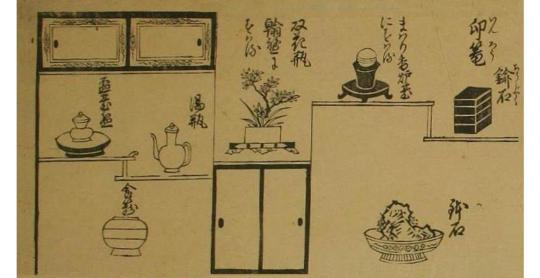
6) This plate corresponds to sketches 6 and 7 in the O-kazari Ki.-- though in the O-kazari Ki (and those versions of the O-kazari Sho where they are separate⁴) there is nothing that indicates that the two chigai-dana were connected in the way shown here.
That aside, the notations all agree with what are found in the earlier source.
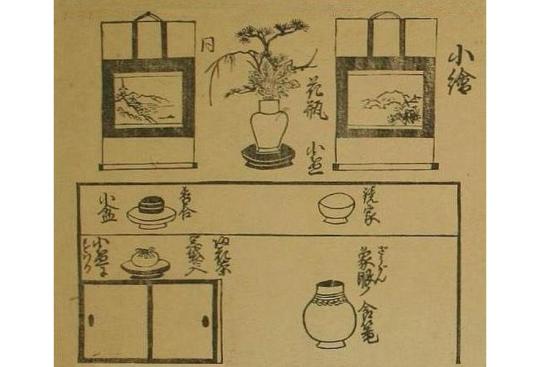
7) In the O-kazari Ki, this plate is included as sketch 8. The name of the object on the right side of the middle shelf is generally interpreted to be kagami-ya [鏡家], the meaning of which is unclear⁵. The other notations either conform with, or elaborate upon, what is believed to have been the contents of Sōami’s original (as mentioned previously, that document has been lost, and the oldest surviving manuscript copy contains a number of copying errors, one of which is present in that version of this illustration⁶).

8) This plate corresponds to sketch 9 in the O-kazari Ki. The details are all in agreement between these two sources (though in this sketch, the pair of hone-haki [骨吐] are not identified as being tsui-kō horimono [堆紅彫物] -- made of tsui-kō carved lacquer) .
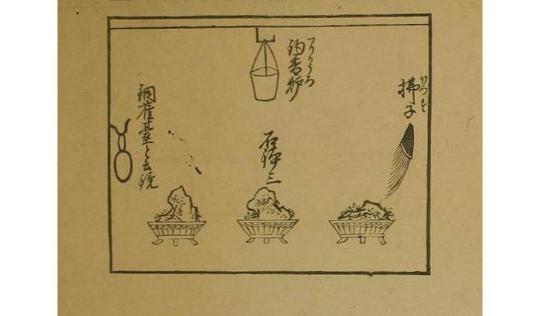
9) This illustration agrees, in all of its particulars, with sketch 10 in the O-kazari Ki. It is a sketch of one arrangement for the tsuke-shoin.

10) This plate is almost identical with sketch 11 in the O-kazari Ki. The difference is that while the O-kazari Ki shows a rectangular jin-bako [沈箱] (which had six compartments for different varieties of incense wood), the O-kazari Sho features a round jin-bako, which had compartments for seven varieties. Nevertheless, both are described as being made from tsui-kō [堆紅] (carved red and black lacquer).
_________________________
¹I will ignore all of this superfluous material, since it postdates the things covered in Book Four of the Nampō Roku by half a century and more.
²It appears that the officials who prepared the O-kazari Sho had access to Sōami’s original manuscript. Therefore they were able to correct many of the miscopyings that are found throughout the oldest surviving manuscript of the O-kazari Ki (which was not made by Sōami himself).
³Joku no ma mo [卓の間も] can also mean “within (the confines) of the table” -- in other words, the amount (or volume) of the table’s surface that is covered by the flower arrangement, or the mass of the arrangement above the table.
If this is what was intended, then the revised version joku no ma mo habikori no ma mo yoku sun wo torite onaji hodo oku-beshi [卓の間も衍の間も よく寸をとりて同ほとに置くへし] would translate “the space above the table that is covered (by the arrangement), and the extent to which the arrangement spreads beyond the table, should both be observed, and (the vase) should be placed (on the table) so that they are essentially the same."
⁴The two sketches are joined together in the Higashiyama-dono O-kazari Sho, suggesting that there was some basis for doing so (since the Higashiyama-dono O-kazari Sho seems to have been copied directly from the original manuscript that was preserved in the shōgun’s household).
⁵In the O-kazari Ki, this object is labeled kagami [鏡], which means a mirror.

In the Higashiyama-dono O-kazari Sho (the relevant sketch from which source is reproduced above), however, it appears to be labeled hikiya [挽家], which would mean the storage box for a chaire (made either of turned wood, or turned ivory, to match the shape of the chaire exactly on the inside). The problem is that hikiya seem to date from a later period than the material contained in these books.
⁶The object on the lower right side is erroneously labeled as a chaki [茶器] in the Imai copy of the O-kazari Ki; but is, in reality, a jikirō [食籠] (a box for the sweets or side-dishes traditionally served to accompany tea or sake).
2 notes
·
View notes
Text
How to Switch Over to Salesforce Lightning: A Seven Step Guide
Switching over to a new system can be a daunting task. Especially when you’re feeling settled with your current process and way of doing things. Fortunately, transiting from Salesforce Classic to Lightning isn’t too difficult if you follow a step-by-step guide such as this.
Firstly, why do you need to upgrade to Salesforce Lightning? You don’t have to transition over to the new system but it’s certainly in your best interest to do so as eventually technical support for the classic version will end, and most the new features are now only available in the Lightning version so you’d be selling yourself short.

Step 1 – Outline goals:
Before you begin to move any processes over to the new system, you need to decide why you want/need to transition. All businesses can benefit from the upgrade to the Lightning version of Salesforce but some companies simply don’t need the functionality enough yet to make the shift. The best thing you can do is create a clear list of goals for the Lightning migration and why you need it more than the classic version. Try and align these with your business goals and highlight how specific new features on the lightning version will help you achieve them.
Step 2 – Prepare teams:
Moving over to the Lightning version has the potential to cause disruptions in workflows as internal processes will also be making a shift as well. It’s an old saying that failing to prepare is preparing to fail, so make sure to train all the affected teams to discuss any concerns before moving onto the development stage. You’ll need to remember to include all teams as every function will use Salesforce differently so a new system will impact them in unusual ways.
Step 3 – Create a battle plan:
The next step is to develop a clear guide for the development team to use during the transition period as it will help to avoid disruptions. By prioritising what features you’d like, scheduling time scales and providing resources for developers to be able to collaborate you can keep bumps in the road to a minimum. This is the point where you need to look at the wider picture to visualise how you might integrate Lightning with outside systems and how this will change the workflow of your teams.
Step 4 – Squash the Bugs:
There’s not much worse than completing a project only to find that it breaks down as soon as its operational. To prevent this, you’re best off running a Lightning Readiness check to pick up on any potential or unforeseen bugs and incompatibilities. Once this is finished, you should use a sandbox to isolate and test changes before an official launch. This allows key stakeholders and Super Users to try the functionality and provide feedback so that updates can be made.
Step 5 – Ensure alignment:
Remember those goals you set out in step 1? Now is the time to check with your stakeholders that the system will accomplish them. If not, you need to go back and change a few things to make sure they’re set to be achieved. Once they’re met then it’s time to launch the program. Start with all changes to Power Users only, as doing this means that each user account can test the new functionality individually. This helps to ensure that each feature lines up with what each user group needs. Be sure to implement their feedback at this stage before releasing it to the whole organisation as it prevents the issues impacting on the rest of the business.
Step 6 – Documentation:
Having a fully functional program is important, but it’s not much good if people don’t know how to use it in the right way. That’s why you need to create a detailed document which outlines workflows and processes so that developers can edit the Lightning system as the business adapts in the future. You can then use this document to train the users on the Lightning functionality before going live to the rest of the company.
Step 7 – System Launch:
The final step is where you can take the system live, but this comes once everyone is fully trained on how to fully utilise it. It’s best to keep a few developers close by following the launch to help with any potential issues that inevitably occur, but after a few weeks, it’s time to let the system administrators take over.
Thinking of switching over to Salesforce Lightning?
System migration and integration can be tricky without professional guidance. That’s why many clients find our help extremely useful in these situations. At Zon Projects, we offer long term solutions that require complex process planning and architecture design. Get in touch today!
Recent Posts
How to Switch Over to Salesforce Lightning: A Seven Step Guide
Lightning Components vs Lightning Web Components: What are they?
Top Tips for Salesforce Lightning
Top 5 Automated Marketing Features You Need to Know About Now
Migrate Salesforce Classic to Lightning
Search for:
Need help? Get in touch
How Can We Help You
We would be happy to have an informal chat with you about your requirements and to offer advice or see if we can be of assistance to you. Please complete our simple form and we will contact you as soon as possible.
R
Help & Advice
R
Project recovery
R
Support & Training
R
Integration to a 3rd party system
Book a Free Appointment
Get in touch
Name
Email Address
Phone Number
Message
Number
3 + 6 =
Submit
The post How to Switch Over to Salesforce Lightning: A Seven Step Guide appeared first on Zon Projects.
Original Post Can Be Found Here: https://ift.tt/2QfOmD9
0 notes
Text
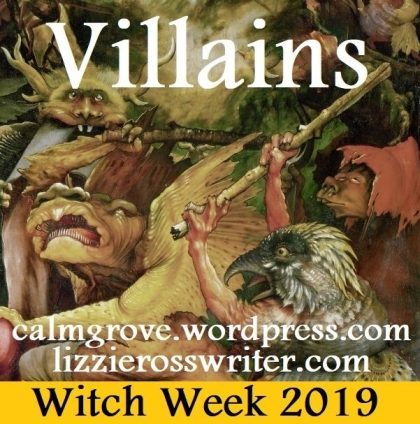
Lizzie Ross, co-convener since 2018 and last year’s co-host for Witch Week, blogs about reading and writing at LizzieRossWriter.com. In this post she rightly draws attention to villains in graphic novels, the range of which may prove surprising to those not familiar with this genre.
Yesterday, Laurie from Relevant Obscurity set the tone for Witch Week 2019 by providing us with a list of despicable qualities found in evil rulers. In this post I apply Laurie’s points to villains of all sorts in fantasy graphic novels. Some of these villains are leaders or want to be; others use/enslave/kill characters to gain power or wealth or longer life; still others just seem to get joy out of causing mayhem. But whatever their motivations, they’re all heinous enough to provide frissons of horror.
Watchmen: The Deluxe Edition, Alan Moore / Dave Gibbons, DC Comics, 1986-1987/2013
Lately, the distinctions between hero and villain in graphic novels have grown nebulous, with sympathetic villains and troubled heroes making it difficult to decide who we’re rooting for. Unlike Jadis in Narnia, whose icy demeanor hides nothing more than a cold lust for power, characters like Watchmen’s Rorschach and Monstress’s Maika Halfwolf have so many flaws their very clothes and skin seem to writhe in agony. And yet, neither is a villain. Nimona kills her enemies with barely an afterthought, finding it more expedient to wipe them out than to negotiate or try to go around them. And yet, we can’t help rooting for her, and she is most definitely not the villain of the story.

Beowulf, Santiago García / David Rubín, Image Comics, 2018
Of course there are still many traditional – that is, unredeemable – graphic novel villains. Grendel in García’s and Rubín’s Beowulf, based on the 1000-year-old Old English poem, is as relentlessly blood-thirsty as a reader could wish and, when finally revealed in a snowy two-page spread, seems to glow with internal fires of hatred. And those teeth!
The Shadow Hero, Gene Luen Yang & Sonny Liew, First Second Books, 2014
Ten Grand and his gweilo cronies, in Gene Luen Yang’s and Sonny Liew’s The Shadow Hero, are traditional noir villains, greedy and ruthless, preying on Chinese immigrants to enrich themselves via bribes and protection money, never hesitating to kill uncooperative “clients”. Then out of the tenements comes the Green Turtle, a reluctant hero who avenges his father’s death and then returns to his quiet life as Hank Chu, shopkeeper. The Green Turtle made his first appearance in the 1940s, joining other Marvel heroes to fight Axis spies, and in their 2014 prequel, Yang and Liew propose an origin story for this superhero – a “tiger mom” and an ancient spirit provide the push, and the superpower, that turn Hank into the Green Turtle.
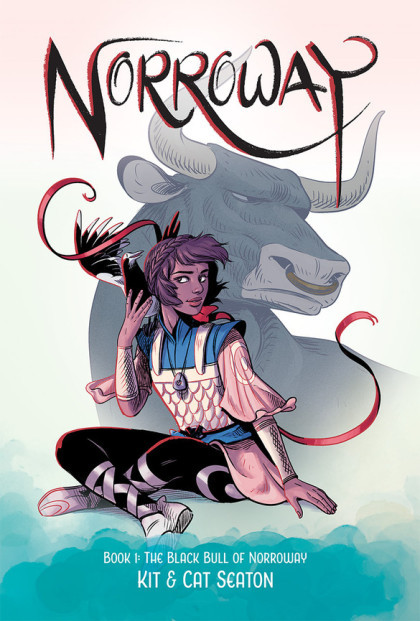
Norroway: Book 1 The Black Bull of Norroway, Kit & Cat Seaton, Image Comics, 2018
Drawing on traditional tales such as Beowulf and well-known fairy stories often results in archetypal heroes and villains. But not always. Sisters Kit and Cat Seaton collaborate as author and illustrator of Norroway: The Black Bull of Norroway, a graphic version of a Scottish fairy tale. The Seatons give us the heroine Sibylla, a stubborn and angry teen fated to marry a bull. At first, we suspect the bull itself – huge and stubborn and easily riled – might be the villain, except that we soon recognize that Sibylla will eventually fall in love with her bull. But before that can happen, she loses him. That’s how Book 1 of this proposed trilogy ends – the subsequent volumes will follow Sibylla on her search and, no doubt, let us know what Brom the Bull is doing in the meantime.
So who, then, is the villain in the Seatons’ tale? Is it Brom’s father, who used his children to lengthen his own life? Is it the Old One who caused Brom’s taurine metamorphosis? Or could it be Sibylla herself, who, as a typical teen, resents every burden placed on her and throws periodic destructive tantrums? Only the first volume of this series has been published, so I have no answers yet. Cat Seaton’s dark and muted palette for her illustrations sets a somber tone, making me wonder if the expected happy ending might not arrive after all. We’ll see.
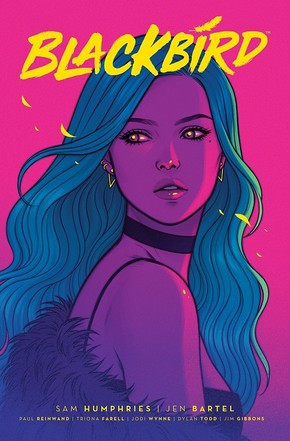
Blackbird: Book 1 The Great Beast, Sam Humphries / Jen Bartel, Image Comics, 2019
Sam Humphries and Jen Bartel in Blackbird give us another angry teen story, set in a modern LA troubled with territorial violence. Cabals of Paragons (magical zombies who look really good for dead people) fight each other for power and new recruits. Nina Rodriguez, the pill-addicted heroine, gets caught up in the battles when her sister is kidnapped by a giant tiger-like beast. Nina’s mother is dead, her alcoholic father AWOL – so Nina’s on her own to rescue her sister. Who can she trust? The handsome flashy guy from the Zon Cabal, or the gorgeous punk blonde from Iridium? As with other villains discussed so far, the evil-doers here seem to be motivated by lust for power. But there’s much still to be revealed as Nina’s tale unfolds, with surprise appearances and the usual plot twists.
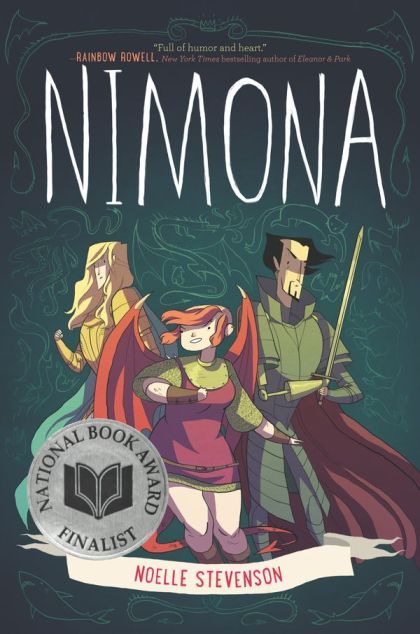
Nimona, Noelle Stevenson, Harper Collins/Harper Teen, 2015
Noelle Stevenson’s Nimona began life as a web comic. Dedicating her book “To all the monster girls”, Stevenson turns heroic and villainous archetypes on their heads. The eponymous protagonist, a chubby girl with a punk haircut, talks her dark idol, the evil Lord Ballister Blackheart, into letting her be his sidekick. “Every villain needs a sidekick.” An orphan with shape-shifting powers, Nimona wants to kill all Blackheart’s enemies, who include Sir Ambrosius Goldenloin (Stevenson isn’t coy with her characters’ names), and manages to kill several of them and destroy a lab on her second day of work – to the dismay of Lord Blackheart, who doesn’t believe it’s necessary to kill anyone just to defeat his enemy. Nimona reluctantly falls in line, but we know there’s more mayhem in her future.
Yes, this is a comedy, and yes, from the start there’s no doubt who the real bad guys are. But Nimona’s actions remind us of a few questions for which there are probably no answers: Can you be a hero if you kill people without regret? Is collateral damage ever justifiable? Is it okay to do the right thing for the wrong reasons? Nimona sets the tone within the first few pages: “We’re villains!” she says to Blackheart. “Villains kill people sometimes!” Later, when he protests her love of violence, she points out, “No one’s ever going to take you seriously if you’re too afraid to kill anyone.” She takes “villainy” seriously, and we can only laugh as we see her unintentionally allied with the good guys. She seems always to be doing the right thing for the wrong reason, even if she’s overly bloody in the process.

Black Panther: A Nation Under Our Feet, Ta-Nehisi Coates and Brian Stelfreeze, Marvel Comics, 2016
As with Nimona, moral ambiguity underlies Black Panther, Watchmen, The Sandman, and Monstress, but all four are serious graphic novels, about who should hold power over the rest of us, and whether anything justifies such power. In Monstrous and The Sandman, that power guarantees longer life; in Black Panther, it leads to increased wealth. And in Watchmen, that power allows one man to create his version of Utopia. He wants a better world, but he doesn’t care who dies to get us there. In all of these, the heroes and heroines are constantly faced with choices – what does each fight demand of them? What are they willing to give up, or compromise, in order to win? Only Black Panther, the rightful ruler of Wakanda, escapes with the least compromised principles, but early on his father tells him, “You’re a good man, with a good heart, and it’s hard for a good man to be king.” It’s a warning to us all.
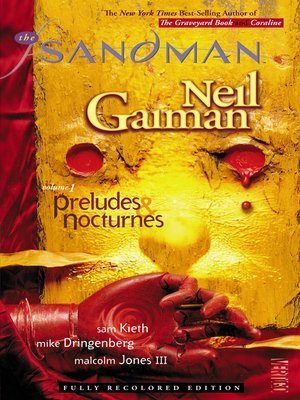
The Sandman, Neil Gaiman /Sam Kieth / Mike Dringenberg / Malcolm Jones III VertigoComics, 1988-89/2010
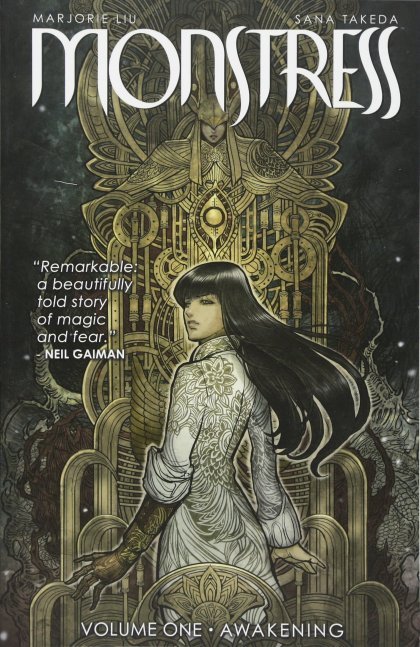
Monstress, Marjorie Liu / Sana Takeda Image Comics, 2016-2018
To round out this list to an even 10, I close with Shaun Tan’s lovely and enheartening The Arrival, a wordless picture book about the wrench of leaving home for a new life elsewhere. There are no villains in this book, unless you want to count the challenges of being a poor immigrant in a new country whose language you don’t know and whose wife and child are still in the old country. But the story is glorious, with otherworldly sepia-toned artwork. Monstrous tentacles twine around the stone buildings and through the streets and skies of a town in the old country. The new country is like something out of Hieronymus Bosch, full of steaming smokestacks, pyramidal skyscrapers, giant beasts (harmless, mostly), and teeming streets. Terrifying because it’s all so strange. Each page needs several minutes to examine. Perhaps most revealing of Tan’s intent here are the endpapers – 60 passport-like “photos” of people of all ethnicities. These, Tan seems to be saying, are the citizens of the new world; get used to it.

The Arrival, Shaun Tan, Arthur A. Levine Books, 2006
I’ve had fantastic fun re-reading old favorites and discovering new graphic authors and artists for this year’s Witch Week. Have I inspired you to pick up one or two of these books, or at least to tell me about your own favorite graphic novel villains? Let me know. And HAPPY WITCH WEEK!
This slideshow requires JavaScript.
Lizzie Ross
Hopefully Lizzie has persuaded you that graphic novels have a wider range of villains than conventional wisdom claims for the comics genre!
#WitchWeek2019 Day 2: Graphic Villainy Lizzie Ross, co-convener since 2018 and last year's co-host for Witch Week, blogs about reading and writing at…
0 notes
Text
April was another weird month to be honest. The car was acting up. My body was being weird (but what is new on that account). The weather was going up and down. But reading wise it all went super!

The Numbers
# Read 60 Books
Read this month: 15
Total: 51/60
Night Shift by Debi Gliori / 5 stars
Little Witches: Magic in Concord / 3 stars // ARC
The Copper Promise (The Copper Cat 1) by Jen williams / 5 stars // Reread

Career OWLS. Other OWLS.
Slayer (Slayer 1) by Kierstin White / 3 stars // OWLS / Ancient Runes // ARC
Stronger Than a Bronze Dragon by Mary Fan / 4 stars // OWLS / Transfiguration // ARC
Red Sister (Book of the Ancestor 1) by Mark Lawrence / 4,5 stars // OWLS / Defence Against the Dark Arts
The Outside by Ada Hoffmann / 4 stars // OWLS / Charms // ARC
Good Omens by Terry Pratchett and Neil Gaiman / 4 stars // OWLS / History of Magic
A Thousand Beginnings and Endings. Edited by Ellen Oh and Elsie Chapman / 4 stars // OWLS / Arithmancy
Nyphon Rising (The Riyria Revelations 3) by Michael J. Sullivan / 3,5 stars // OWLS / Herbology
Artificial Condition (Murderbot Diaries 2) by Martha Wells / 4 stars // OWLS / Potions
A Thousand Perfect Notes by C.G. Drews / 4 stars // OWLS / Muggle Studies
All Star Batman and Robin, the Boy Wonder (All Star Batman and Robin, The Boy Wonder vol. 1) / 2,5 stars // OWLS / Astronomy // Graphic Novel
The Abyss Surrounds Us (The Abyss Surrounds Us 1) by Emily Skrutskie / 3 stars // OWLS / Care of Magical Creatures
Holiday in Death (In Death 7) by J.D. Robb / 4 stars // OWLS / Divination
I managed to finish all OWLS needed for my career AND I read the 4 extra owls. I am best pleased!
AVERAGE: 3,53
#gallery-0-5 { margin: auto; } #gallery-0-5 .gallery-item { float: left; margin-top: 10px; text-align: center; width: 33%; } #gallery-0-5 img { border: 2px solid #cfcfcf; } #gallery-0-5 .gallery-caption { margin-left: 0; } /* see gallery_shortcode() in wp-includes/media.php */
Fire Breathing Dragon: 12/20
Prompts Completed This Month: Warrior / Uncommon Fantasy Creatures / Pirates
Complete Alien: 6/20
Prompts Completed This Month: Space Creatures / Space Ship
Generic Robot: 7/12
Prompts Completed This Month: Under 500 Pages / Satire
Total: 24/52
Read more about my own reading challenge here.

Level: Elemental Witch (11-15 retellings)
Read This Month: 2
Total: 13/15
I’ll show and update with the bingo card every 3 months here.
⌘ So instead of health problems at the start of the month I now had car problems. My car had its yearly check up at the end of February. In March I had to return to fix a shake while driving. And in April I seemed to have problems with my cooling system. It was not fun. I gave me a lot of stress and sadness. I tried very hard not to let it rule me. It got fixed and as we were driving back from my parents at Easter, another light went on. Grr.
⌘ The change of the clock at the end of March messed a bit with Merijn’s sense of bed time and he keeps coming out of bed for 30 minutes. I hope he’ll get used to it again because it being light when he goes to bed is just going to get worse.
⌘ We got some fun bits for our garden to cheer it up.
⌘ We took Merijn to a fairytale theme park more geared towards his age with a very large playground as well. He loved it. He was so tired but he loved it.
⌘ Then a few days later Merijn got the sixth disease/roseola. He broke out in bumps and red splots over night, ended up with a high fever for 24 hours and then his temperature went back to normal. The break out took a few days longer to go away, een more so with some of the warmer days we had. He was better in time for Easter
⌘ For Easter we went to my parents. Which was fine. We had some great weather. Merijn stayed the week with my parents and we went back on King’s Day.
⌘ For some reason I got a bad case of hayfever? And then I woke up the last weekend of April and I had a swollen, stiff and sometimes painful knee. Who even knows what I did…
Reviews
⌘ The Unicorn Anthology. Edited by Peter S. Beagle and Jacob Weissman // ARC
⌘ The Beauty and the Beast by Gabriella-Suzanna Barbot de Villeneuve
⌘ Slayer (Slayer 1) by Kierstin White // ARC
⌘ Red Sister (Book of the Ancestor 1) by Mark Lawrence
⌘ Good Omens by Terry Pratchett and Neil Gaiman
Top Ten Tuesday
Things That Make Me Pick Up a Book / Older Books I Don’t Want You to Forget About! / Ten Rainy Day Reads / Eight Blog Posts I Think Give You the Best Glimpse of Me
Other Posts
Dancing out of March 2019 / Best of the Bunch // March 2019 / Dancing Versus – The Passage / Snapping Those Bookish Pictures / Why Do I Seem to Have So Many Reading Goals but Rarely Any Personal Goals? / Buying Full Series Before Reading the First Book: How Has That Been Working Out for Me? / Is Limited Third Person Point of View Still My Favorite? / Book Haul #42 / In Which Spring Arrived with Sequels / With Which Characters Would I Describe Myself?

⌘ The Lost City of Z / Movie / DNF
I watched a good portion of this but it was a bit boring and I couldn’t really care about any of the characters.
⌘ The Warrior’s Gate / Movie / DNF
I couldn’t do it. This screamed white savior all over it. Also why in hells name would a chinese man give a white teenage boy that works for him a family heirloom?
⌘ Spirited Away / Movie / Rewatch
⌘ Goosebumps / Movie
I was excited to see they were showing this here and I liked the humor at the start. Then it kind of dwindled and I think Jack Black was trying a bit too hard to be honest.
⌘ Inspector Lewis / Season 1 / Ep 1-4 / Rewatch / COMPLETED
⌘ Game of Thrones / Season 6 / Ep 1-8
Well I finally started this season now everyone is watching the final season, lol.
In April I participated in Anderwereld’s #aprilmeetthebookworm photo challenge so here you can see the picture I took for that.

You and your shelf / What are you currently reading / Golden Oldie
Favorite Reread / How long have you been reading? / First Fantasy Book
Favorite Writer / TBR / Reading Spot

Reading Buddy / Favorite Fantasy World / Biggest Book on Your Shelf
Special Book to You / Favorite Bookish Item / Most Fun Reading Memory
Your Reading Goal / Favorite Bookish Quote / A Genre You Still Want to Try

Favorite Drink / Pleasant Surprise
Bookmarks / Your Biggest Treasure
Best Meeting in the Bookish World / Your Favorite Book Store

Your Favorite Series / Your Favorite Blog/Site
Favorite Reading Snack / Favorite Character
April Book Haul / April Wrap Up
Blogs
⌘ Cait from Paper Fury talks about what it is like to write an own voices book. She also shares a collab post with other autistic bloggers/authors about what they would like to see more in books regarding autism. And here was a book shelf tour!
⌘ Fadwa from Word Wonders recommends books based on the twelve zodiac signs.
⌘ Vicky from Vicky Who Reads created a tutorial about DIY sprayed edges.
⌘ Krysta from Pages Unbound asks where the ya books for younger teens are.
⌘ Lindsey from Lindsey Reads shared ten inspirational quotes for introverts.
Dutch Blogs
⌘ I wrote a guest blog in Dutch for Anderwereld about why second-hand books are fun too.
⌘ Emmy from Zon en Maan did another compliments for book bloggers survey and has posted the results with the compliments.

⌘ It is WYRD AND WONDER TIME! I’ve already started on May 1st with some posts for this fantasy themed month and of course so shall be my reading.
⌘ Other than that I don’t really know. I guess I’ll be working on the blog some. And I kind of really need to get on those pictures. But that might be more of a Summer evening task. You know, those nights that you can’t sleep on time anyway because its so hot?
This monthly wrap up will be linked up with the monthly one by Nicole @ Feed Your Fiction Addiction. This so we can blog hop to each others wrap ups easier.

Dancing out of April 2019 April was another weird month to be honest. The car was acting up. My body was being weird (but what is new on that account).
0 notes
Text
How to Insert Google Calendar, Apple Calendar & Outlook Event Invites Into Your Marketing Emails

Have you ever registered for a webinar and then totally forgotten about it? Or perhaps you got an email about an upcoming workshop, but you were busy and forgot to put a reminder in your calendar for it? Yep, I'm guessing that's happened even to the most type-A of us.
Well, if you're an email marketer, you've been on the other side of this, when half of the registrants for an event you promoted never showed up. It sucks.
Luckily for you, you don't have to worry about that anymore, because we're about to share a marketing hack with you: how to insert Outlook, Apple Calendar, and Google Calendar invites right into your email in a few easy steps. That way, registrants can add the event directly to their calendars, and then be much less likely to forget about your event.
Download our free guide here for even more tips to optimize your email marketing.
Unless you somehow magically know what type of calendar your target audience uses, your best bet is to include all three major calendar invites in your email, giving recipients a choice that works for them. Outlook and Apple Calendar users will get an .ics file and Google Calendar users will use a URL-based custom invitation.
Note: All screenshots and steps were taken on a Mac, but if you're on a PC, the process is similar.
Step 1: Create a New Event
If you have a Mac, you can create your invitation in Apple Calendar. If you have a PC, you can create it in Outlook. For Google Calendar, you'll create the URL directly from your calendar application (you'll need to be logged into your Google account to do this) -- it doesn't matter which type of computer you have.
Apple Calendar
Open Apple Calendar and click on the "+" sign in the top left corner of the window. A pop-up will appear. Enter the name of your event in the "Create Quick Event" box and hit return/enter on your keyboard. This will create an event on your calendar, but it will place the event on the current date and time and leave the rest of the details blank. You'll need to change this information to reflect the details of your event (more on that in the next section).

Outlook
Open up Outlook Calendar, then click on the "New Items" icon or click "New Appointment" in the navigation bar and select it from the dropdown. You're setting up an appointment, not a meeting, because this is an individual invite and other people from your recipient's calendar will not be included on it. A calendar invite will pop up for editing.

Google Calendar
Open Google Calendar in a new browser window. You'll need to be logged into your Google account. Click the red "Create" button on the top left side of the screen. A new event window should open.

Step 2: Set Details for Your Event
While Outlook, Apple Calendar, and Google Calendar events have slightly different formats, you'll still need the same components for each one:
Event name
Location
Time
Event description
URL of your event's landing page
Optional event alert
Below are examples of how these details look in the different applications, as well as a clarification of what information and format to use for each of these components.
Apple Calendar

Outlook

Source: Northern Arizona University
Google Calendar

The Details You Need to Include
Event Name (Subject field in Outlook)
Make sure the name reflects what your actual event name is called on your website and in your other promotions (this is a no-brainer, but we're being thorough here). You may want to also include your company name at the end so registrants can quickly remember who is hosting the event when they stumble on it in their calendar later.
Location
Physical address of the event (one line, such as "123 Business Ave, Springfield, TX") or the landing page URL, in the case of an online event.
Time
Enter the start and end dates and times of the actual event. Adjust the timing of the event to your time zone, as you're the one creating the .ics file. It will automatically change the time to correspond with each person's time zone. For example, if you're creating the event file in Boston for a webinar in San Francisco that starts at 10 a.m. PST, you should enter the start time as 1 p.m. EST.
Alert (Optional)
You can set up alerts so attendees don't forget about the event between when you sent the invite and the time of the event. In Outlook, you can set a time for one reminder to go off (such as one hour before). In Apple Calendar and Google Calendar you can set multiple alerts.
It's important to not overwhelm people with too many alerts, as this creates a negative, intrusive experience. Below is an example of an alert sequence in Apple Calendar that reminds folks about your event but isn't in-your-face:

URL of Event Landing Page
Do you have a specific landing page for your event or webinar? Include its URL, as it acts as a refresher for those who may be fuzzy on the details of what the event is about. Include it in the URL section of an Apple Calendar invite as well as in the body text of your Gmail or Outlook invites if you haven't already included it in the Location section.
Description
Here, you should include a snippet of the event's details. This goes in the "note" section of your Apple Calendar invite, in the body of your Outlook invite, or in the "description" text box in Google Calendar.
It's also helpful to provide your contact info in this section. That way, people can reach out if they have any questions.
Step 3: Save Your Event
Once you're all set editing the invite, you can save it to use as an attachment in your marketing email.
Outlook
Click "Save and Close" in the top-left of your Outlook invite to save it to your calendar. Then, click and drag the appointment from your Outlook calendar to your desktop to use for your email invite.

Apple Calendar
Click "done" to save it to your calendar. Then, navigate to the event date on your calendar, click on the event, and drag it to your desktop. Now you've saved your .ics file to use for your email invite.

Google Calendar
Click "Save" to save your event to your calendar. Re-open the event and click on "Publish Event". A pop-up will appear with an embed code and a link you can easily copy and paste into your marketing email.


Step 4: Insert Invites Into Your Marketing Email
Now that you have events created for Outlook, Apple Calendar, and Google Calendar, you can insert these into your marketing email. You can either link your invites to text or a call-to-action button.
For Apple Calendar and Outlook invites, you'll need to attach the .ics file link to text or a button. Most email tools, such as HubSpot's, have a file manager in which you can upload these files directly from the editing window. Highlight the text or click on the button you want to link to, then upload the .ics file to your file manager and attach it to that text or button.
For the Google Calendar invite, link the text or button to the event URL you grabbed in Step 3 of this tutorial.
Here are some examples of how your invite might look in an email once it's hyperlinked (PS -- you can make your own buttons easily using this template):



Ultimately, even if you go to the ends of the earth to promote your event, it's up to event registrants to actually show up. Everyone's busy -- work, kids, 5K training, you name it -- and it's easy to lose track of events. Lend your audience a helping hand with a calendar reminder so they remember to attend that workshop or webinar they signed up for.
What strategies do you use to reminds attendees of your marketing events? Share with us in the comments below.
Editor's Note: This post was originally published in June 2014 and has been updated for freshness, accuracy, and comprehensiveness.


from HubSpot Marketing Blog https://blog.hubspot.com/marketing/calendar-invites-ical-outlook-google
0 notes
Text
Slingly Pro Review – Hidden Secrets !
Slingly Pro Review – What is Slingly Pro ?
Welcome to my Slingly Pro Review. Slingly Pro is a brand new method created by Ricky Mataka. I was talking about Meaningful conversation about the future of E-commerce and advertising. A reality is… there is 1 year or so left before things gain out of power. It will get a lot harder, and substantially more costly on the off chance that you pause and sit idle, so …As usual, many affiliate marketers are promoting this Slingly Pro to their email list. Maybe you are one of them who saw their promotions and came here to read an honest Slingly Pro review.
See my full review : https://imsaikat.com/slingly-pro-review/
Slingly Pro Review
You want to know if Slingly Pro works or not ! Right ? So welcome to my honest Slingly Pro review based on real user’s results and opinions. Comment below your experience and results using this Slingly Pro below. It will help our readers to make decisions .
Slingly Pro Review- Vendor Introduction
vendor
As I am doing the most honest Slingly Pro Review, so I should also give a introduction about the vendors.
As we know Slingly Pro is basically created and developed by Ricky Mataka.
Ricky Mataka is one of most BIG profile on Clickbank. He is TOP 1% Vendor as well as TOP 1 % affiliate at Clickbank. Each and and every of his launches sold over 2000+ units ! Like you can say – Ninja Optin, WP Social Tapper,WP Social Zon,QuakeMix Traffic Edition,Contest Domination,FanBoom! and lots of more.
You should know that he has made over 78,000+ sales on Warrior+Plus. In addition 31 of his products are Deal Of The Day of the mentioned network
Slingly Pro Review – My Personal thoughts
After seeing their sales page and lots of promotional emails you can expect or dream a lot of things from Slingly Pro. This is natural . People fall for promises.
Let me explain, suppose a product or course named X can be workable for one and can be not working for another person.
Before buying any product you must know if it will fit you or not.
And as usual , these types of softwares and courses like Slingly Pro give a lot of reasons and promises why you should purchase this.
But we always try to advise our readers to do more thinking and do some research before falling for something which may not work for you.
You obviously should have noticed that, every week more than 7-10 products/softwares are launched and everyone promises you a lot ! Products are launching one after one !
So, will you buy every product or you should stick with one PROVEN method ?
And before I continue,
I want to let you know that if you are still struggling to make money online and searching for a real solution that can transform your life then – It will must change your life :
Learn How You Can Copy My $1,000 Per Day Part Time Business…
…even if you’ve never made a dime online before”
Go Here To Check Out Everything
And Learn How You Can Make Your First Commission Online This Week…
…even if you’ve never made a dime online before!
Go Here To Check Out Everything
Slingly Pro Review : Overview
Vendor Ricky Mataka
Product Slingly Pro
Front-End Price $297
Launch Date 2020-Apr-27
Launch Time 11:00 EDT
Commission 50%
Product Type eCommerce
Refund Yes, 30 Days Money Back Guarantee
Skill Level Needed All Levels
Support Effective Support
Slingly Pro Review : Features
[+] 1Earn 50% Commissions For Each Sale On A Proven Product
Earn some HUGE COMMISSIONS we have paid affiliates over 1.5MIL in commissions with our promotions and people who have raved over our products / software and services!
[+] 2Over 1.8 Million Invested In The Platform
We have been working on this software for over 4 years now with over 1.5M invested into the platform itself. We have 10 people working on Slingly daily and it our goal to keep making the platform better then anything that exists in our market! Slingly services exceed the expectations and produce our customers results!
[+] 310% Commissons @ 2nd Tier – With The New Kartra Platform Integrated
Not only does your subscribers win for giving them this opportunity, but we also pay 10% on a second tier commission. So if you LOVE what we do, refer people to us and we will crush it for EVERYONE
[+] 1Steve & Even Tan Ultimate Ecommerce System 3K Ticket
Slingly Pro Review-tiket 1
[+] 2Market Place Profits $997 Ticket Over 250K Collected
Slingly Pro Review-tiket 2
[+] 3Mike Filsame Groove Pages $497 Ticket – 1 Click Upsell $42 Collected
Mike Filsaime Put Slingly Pro 297 VSL Behind His Launch & Did 42K On 1 Click Upsell
It was actually over 50K this was a earlier screenshot
Slingly Pro Review -tiket 3
Slingly Pro Review -tiket 3
Top JV Partners Of Slingly
We Are Making Ecommerce EASY!
Slingly Has Grown Rapidly Over The Past 4 Years
Empowering Ecommerce With Quality Time Tested Automation
Our Proven HIGH-Converting System & Amazing Groundbreaking Software Means Everybody Wins!
Slingly Pro Review -1
7 FIGURE E-COM Traning INCLUDED
With this preparation, you will get full total access to:
[+] Make you go Training camp
[+] Get You Propelled Training camp (worth $297)
[+] The day after Thanksgiving Training camp (worth $697)
[+] Custom Item Recipe Training camp (worth $147)
[+] $2 Million Dollar Unit Preparing
Slingly Pro Review -traffic
Learn How You Can Copy My $1,000 Per Day Part Time Business…
…even if you’ve never made a dime online before
Go Here To Check Out Everything
And Learn How You Can Make Your First Commission Online This Week…
…even if you’ve never made a dime online before!
Go Here To Check Out Everything
So, Should you Buy Slingly Pro ?
First, it depends on you. You need to think about whether you should invest your money and time on Slingly Pro or not.
But keep in mind that you can also lose your money if it won’t work ! It doesn’t matter what type of promising they claimed you .
If it’s your type then there’s a chance it may work but if not you will just lose. So think twice if this fits you before purchase.
I am not discouraging you to buy this but just try to warn you. Many people fall for promises and lose their money by buying products after products. So, you must be determined !
In the end,
this Slingly Pro review post offers users leave their honest reviews after testing and experiencing this product.
Anyone can give their positive testimonials or scam report if it is ! Feel free to comment below if you have tested this product and if any results. Also if it does not work, you are welcome to let us know below on this post.
Our readers will benefit with your honest real user review. And we will know the real performance of this product.
Conclusion :
So, before I finish the Slingly Pro review, I want you to know that to build a real online business, you need the best and working online marketing methods and funnels created by the best person in the industry .
Instead of buying products after products blindly and getting into something you don’t know about, see my no#1 recommendation https://imsaikat.com/Start-Journey and see exactly how to make $200 – $300 per day as a complete newbie without having any website, list or any complicated process. Work on something that is working now and changing many people’s lives every day with LIVE proofs and testimonials .
And before You Leave,
I want to let you know that if you are still struggling to make money online and searching for a real solution that can transform your life then – It may help you :
Slingly Pro Review -proof
Learn How You Can Copy My $1,000 Per Day Part Time Business…
…even if you’ve never made a dime online before
Go Here To Check Out Everything
And Learn How You Can Make Your First Commission Online This Week…
…even if you’ve never made a dime online before!
Go Here To Check Out Everything
This is just a life changer in single sentence !
So, thanks for reading my honest Slingly Pro review and don’t forget to comment below of your thoughts
See my full review : https://imsaikat.com/slingly-pro-review/
0 notes
Text
Hit Parade: The best EICMA Bikes of 2019
In the moto world, EICMA is the Greatest Show On Earth. Held at the gigantic Rho Fiera exhibition center in Milan, it’s spread over several pavilions—and you can easily walk several kilometers a day without seeing everything on display.
All the big guns wheel out their concepts and new launches at EICMA, along with countless range refreshes and minor updates. So we’ve sifted through all the PR bumf and picked out the bikes we reckon have a significant chance of success—or are game changers in some way.
Husqvarna Norden 901 concept After wowing previous shows with the Vitpilen and Svartpilen, Husqvarna has turned its attention to the ADV market with the twin-cylinder Norden 901.
The styling is crisp and original, and the specs suggest serious capability—starting with a 21-inch front wheel and 18-inch rear. Parent company KTM knows how to build dirt bikes, so we have high expectations for the Norden.
The key phrase in Husqvarna’s press release is “class-leading lightness.” Few specs are available, but we know that the engine is 889 cc—the same size as the newly announced KTM 890 Duke R.
There’s no word on a release date, but Husqvarna tends to put its concepts into production—and that can only be a good thing for the notoriously conservative ADV market.
Harley-Davidson Bronx prototype So we now have a name, and some specs too. Harley’s liquid-cooled streetfighter will have a 975cc ‘Revolution Max’ engine—a DOHC 60-degree V-twin with a counterbalancer. The engine is a stressed member of the frame, and it’ll pump out at least 115 hp and 70 lb.-ft of torque. We’re also told that Brembo and Michelin are working on brakes and tires.
It looks good too, poised and muscular, with little visual bloat. There are just two (very big) unknowns: weight and price. If the Bronx isn’t competitive on those fronts, it will have a hard time in the showrooms.
The good news is that Milwaukee has finally delivered the bike so many have asked for. It’ll be competition for the Kawasaki Z900 and Yamaha MT-09, and may even draw some buyers away from the Triumph Speed Triple.
Scrambler Ducati Desert X concept Over the past four years, Ducati has frequently tweaked its Scrambler recipe, adding an 1100 engine to its steady flow of new models. Everything has been firmly ‘retro’—until now.
The Desert X concept catapults the Scrambler into the modern ADV segment, with a nod in the direction of the cultish Cagiva Elefant from the 90s.
The styling comes from the creased paper school, but in this instance it works exceptionally well. The ‘X’ uses the 1,079cc air-cooled engine, has a 21-inch front wheel and two fuel tanks, and a robust luggage rack. It also sports a pair of Dakar-style round LED headlights.
There was also a Motard concept on display, but that was a painting-by-numbers exercise compared to the Desert X—which was in danger of overshadowing the new Streetfighter V4 on the Ducati stand. We’d be surprised if this doesn’t go into production next year. Asphalt & Rubber has the full rundown.
Supercharged Bimota TesiH2 In a move guaranteed to get sportbike fans fizzing at the bunghole, Kawasaki Europe has bought into Bimota. The Swiss owners still retain a majority stake by a very slim margin.
This means that future Bimotas will have Kawasaki power. The iconic Italian marque has celebrated with the launch of the frankly bonkers TesiH2, and there are no prizes for guessing what engine is used.
Bimota has spent a large part of its history since the early 1970s scrabbling to make ends meet, so Kawasaki’s involvement is A Good Thing. Rumors are already swirling about the practical aspects of the deal—with talk of a new factory, and the possible return of former chief engineer Pierluigi Marconi.
But for now, we’ll just enjoy the ridiculous excess of the TesiH2, and rejoice that Bimota finally has a measure of financial stability.
Moto Guzzi V85 TT Travel The rugged, air-cooled V85 is one of the better-looking ADV bikes on the market, and its simplicity is a refreshing change from the techno-monsters that usually dominate the sales charts.
Moto Guzzi has just released a new variant called the Travel, which amps up the retro cool factor even higher. It’ll go on sale next year, complete with big aluminum panniers, a tall windscreen, heated grips and other goodies—plus a lovely ‘Sabbia Namib’ livery.
Officine Rossopuro also came to the V85 TT party with a custom called ‘Orizzonte.’ Aiming to give the V85 a more vintage look, builder Filippo Barbacane has modified the frame, installed Bitubo suspension, and crafted new bodywork (including a headlight that harks back to the classic NTX750). New exhaust pipework is terminated with a MassMoto can, and on the righthand side a curved aluminum toolbox mirrors the shape of the muffler. Weight is an admirable 188 kilos [415 pounds] dry.
BMW Concept R18 /2 It’s interesting to note that while Milwaukee is turning its focus away from heavyweight cruisers, BMW is heading in the opposite direction. The Germans launched the S 1000 XR sportbike and a pair of F 900 roadsters, but all eyes were on the latest ‘Heritage’ concept.
The gestation of the R18 has been extraordinarily long. We’ve already had the CW Zon ‘Departed’ build and the Revival Cycles ‘Birdcage,’ and a few months ago we saw ‘Concept 1’ in the Concorso d’Eleganza show at Lake Como, Italy.
This latest machine edges closer to production with a visible airbox, regular brakes, and all the trimmings you’d expect to see on a factory machine. Images suggest that the prototype was built with the help of the Swedish outfit Unique Custom Cycles—a relationship forged in the days when Swede Ola Stenegard was handling design for BMW.
The styling suggests that BMW is pitching this one at Dyna fans with more cash (and class) than the ‘Dyna Bro’ crowd. It’ll be interesting to see how it plays out.
Best of the rest Also at EICMA was the Harley-Davidson Pan America ADV behemoth, with a 1,250 cc version of the engine used in the Bronx. Triumph had a quiet show with modest upgrades: a TFC version of the Bobber, an RS version of the Thruxton, and ‘Bud Ekins’ limited editions of the Bonneville T100 and T120.
Yamaha unveiled a restyled Tracer 700 with a Euro 5 engine, Suzuki launched the V-Strom 1050 (no DR Big, sorry), and Aprilia is attempting to kickstart the long-dead middleweight sportbike category with its RS 660.
KTM showed its 390 Adventure production ADV bike, Husqvarna tweaked its street bikes and showed a new 701 Enduro, and Honda revealed a CB4X sport touring concept with striking styling [above]. But like many Honda concepts, we’ll probably never see anything more of it.
The biggest surprise? No electric bikes from the big-name makers. The car industry is moving towards alternative power at a rapid pace, but so far, only Harley has dipped a toe into the turbulent waters on the moto side.
Still, there was plenty to enjoy from EICMA this year, and it suggests a European industry in rude health. Let us know if we’ve missed any winners from your scorecard.
0 notes